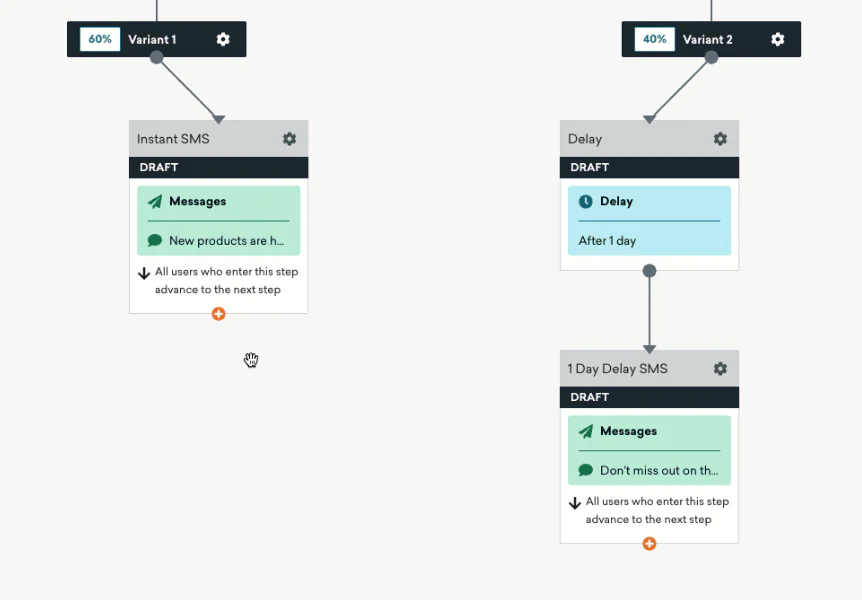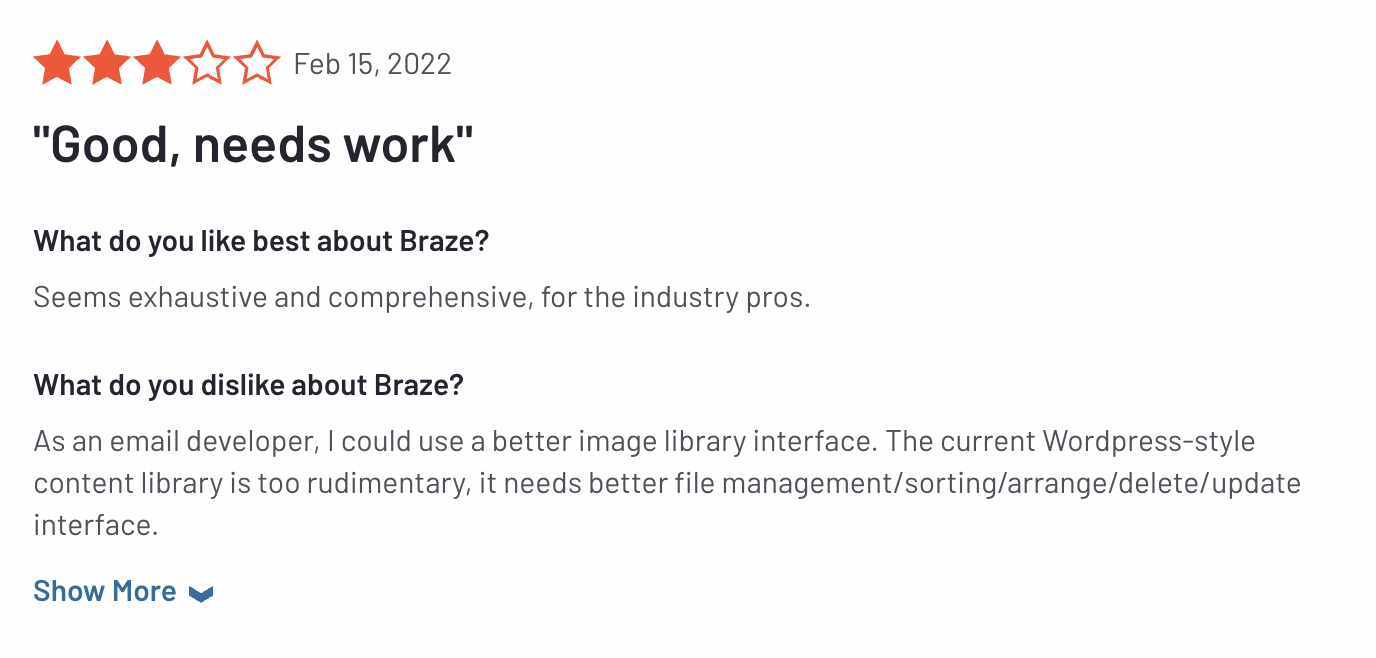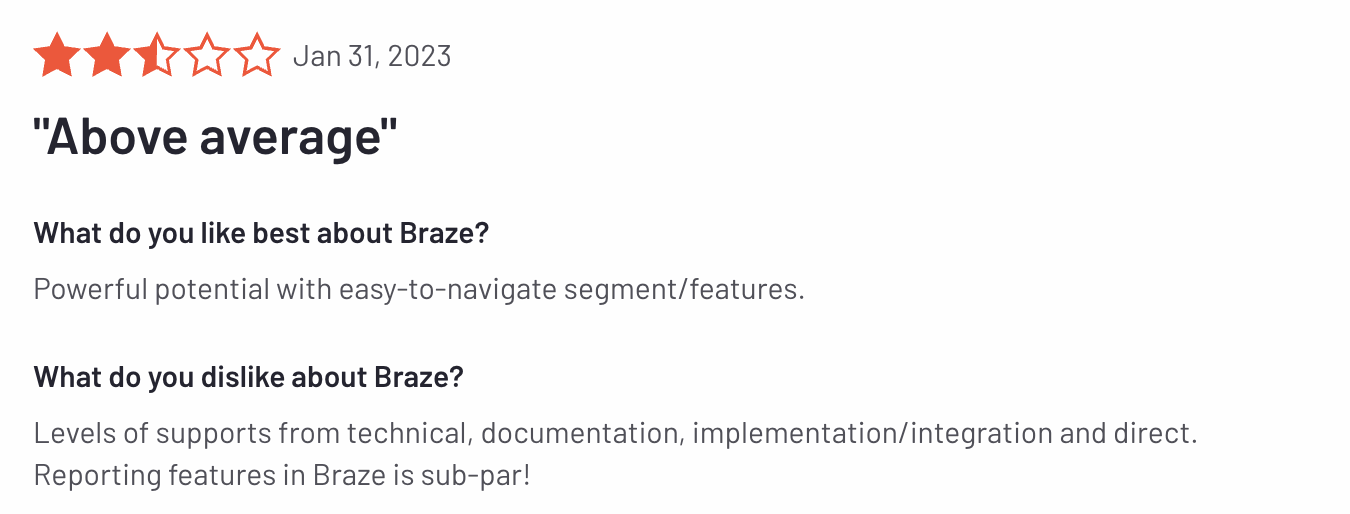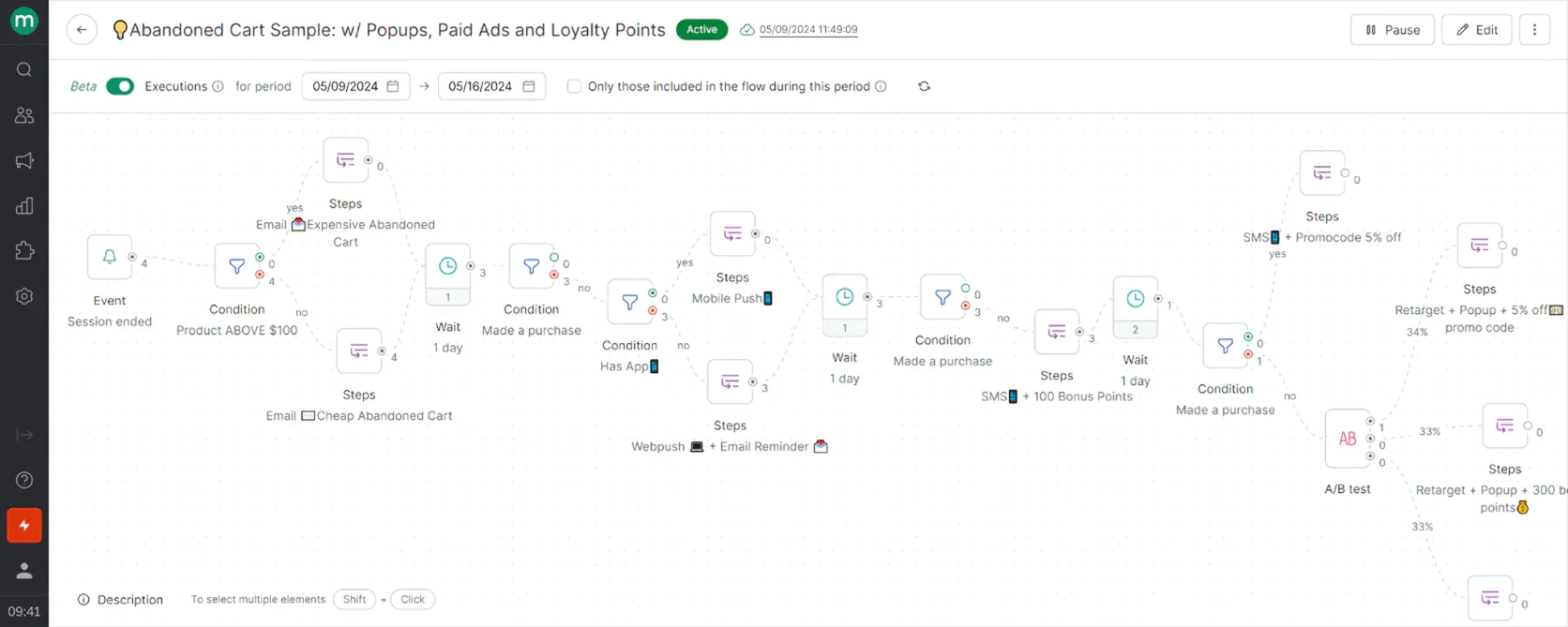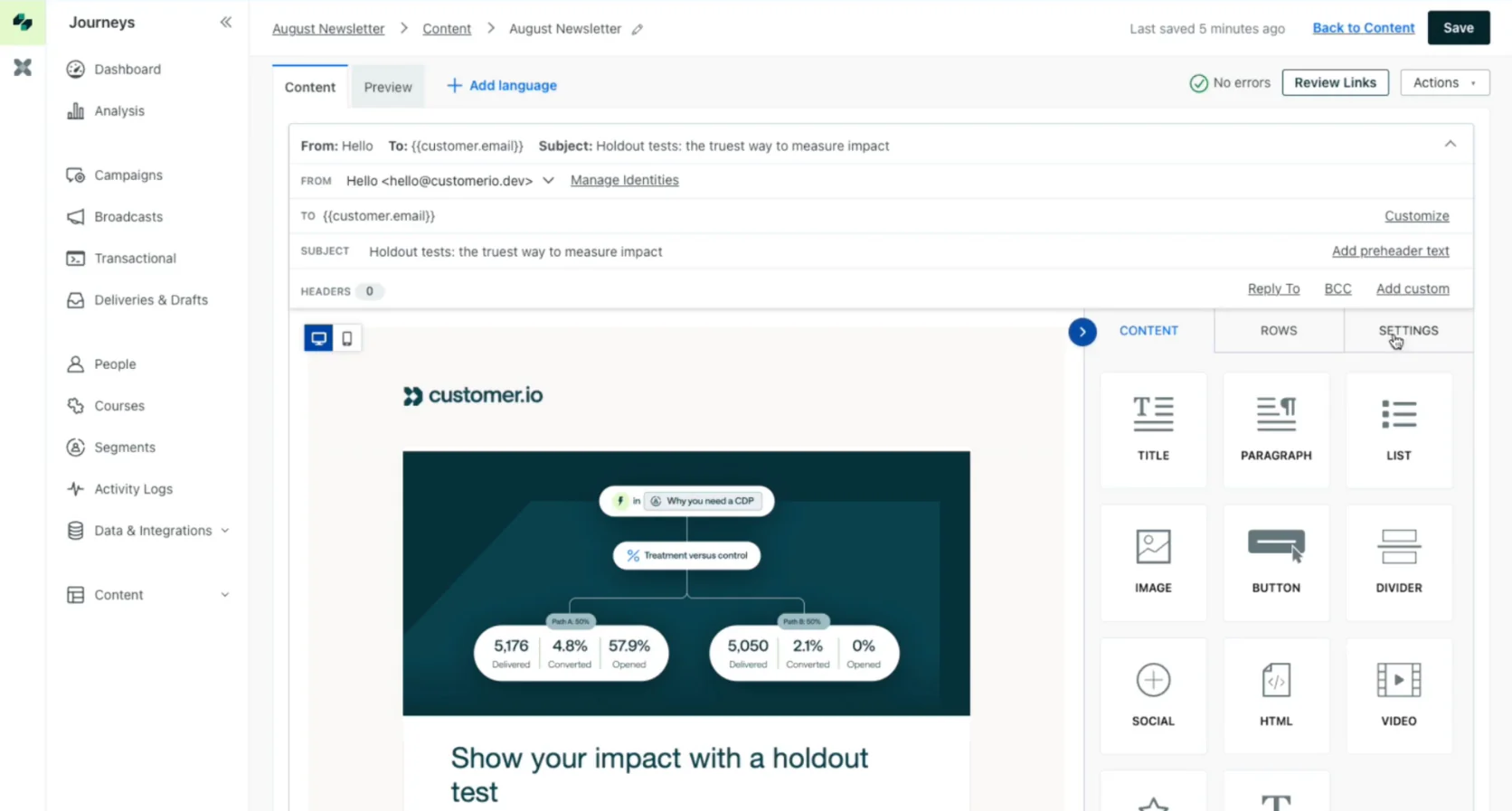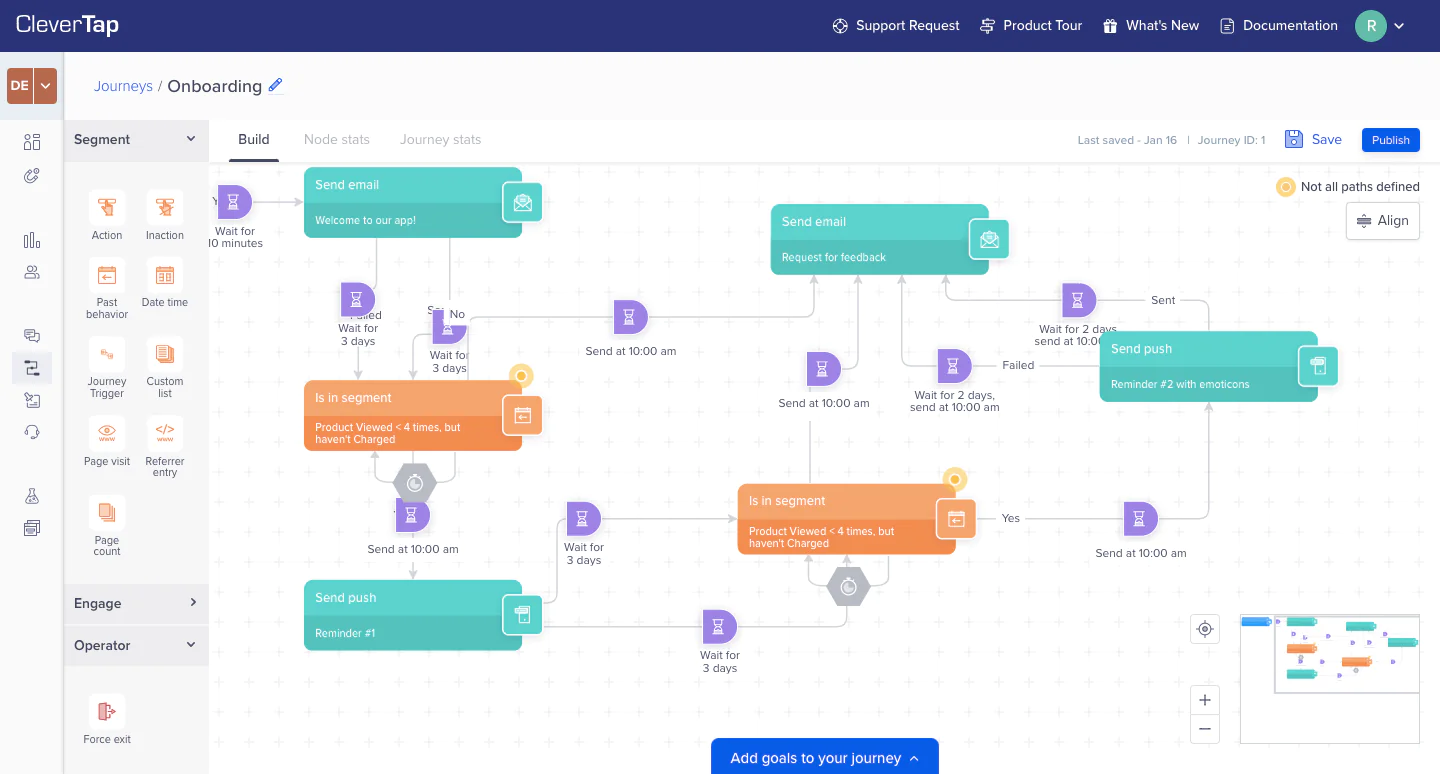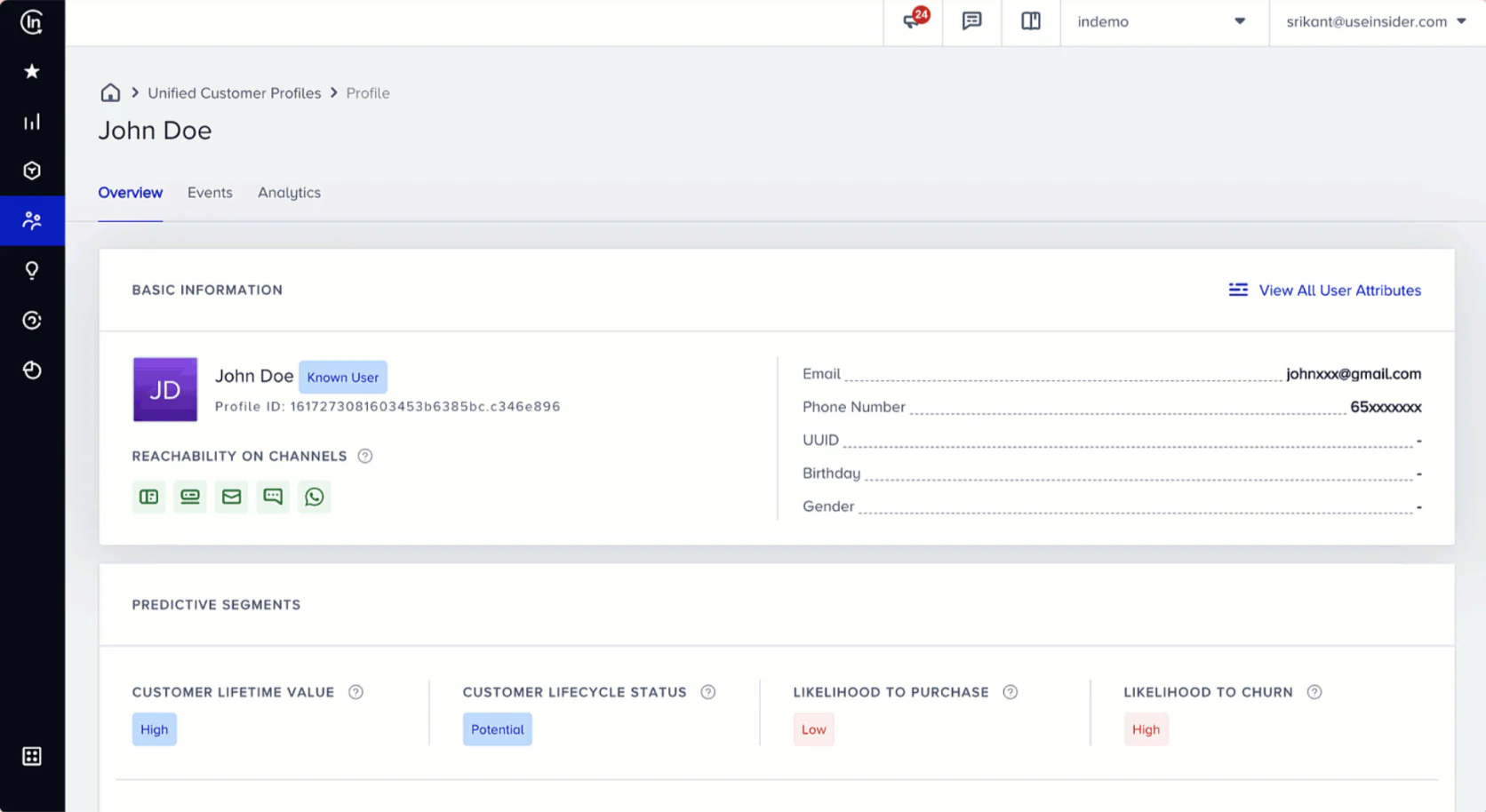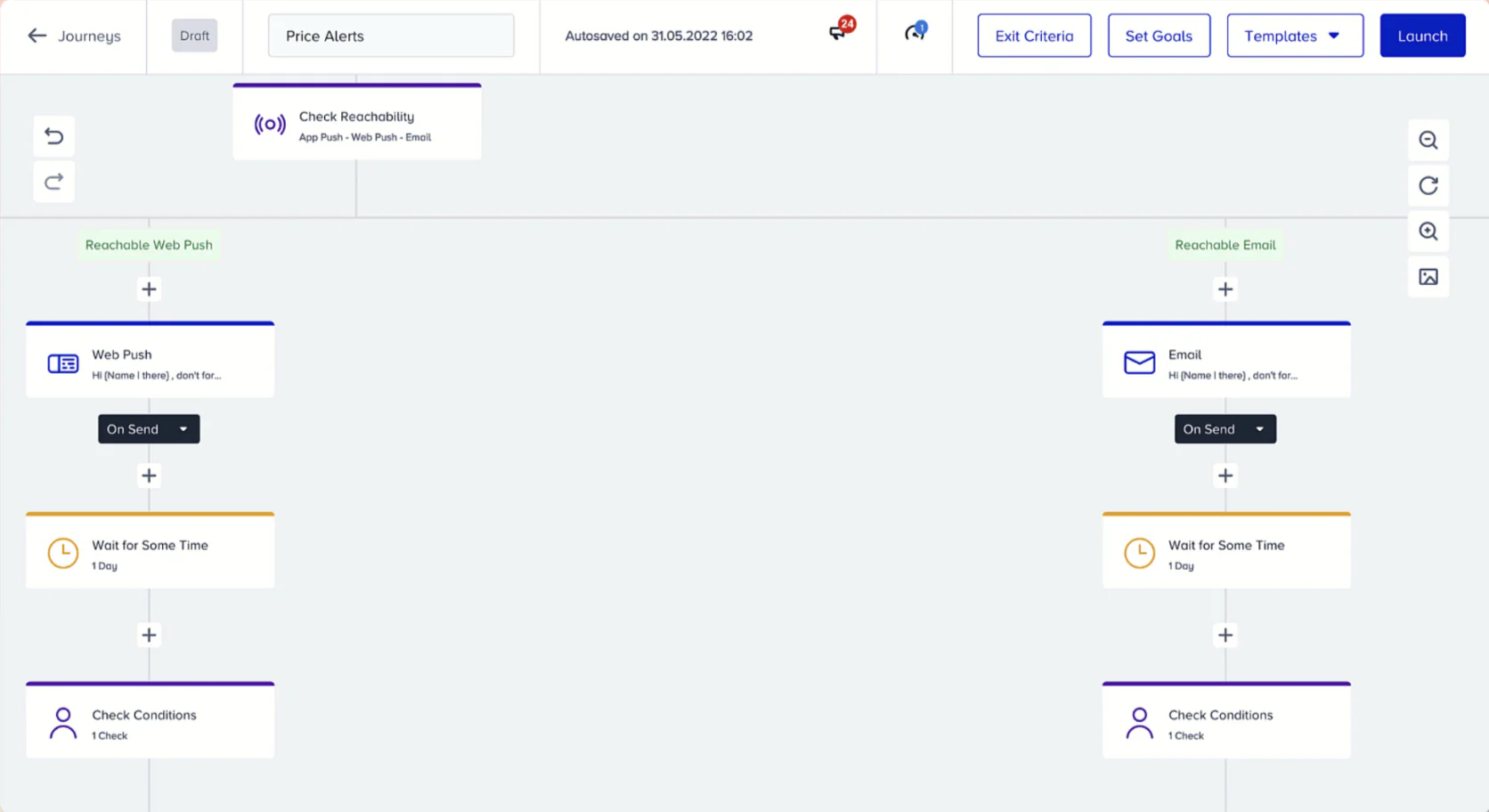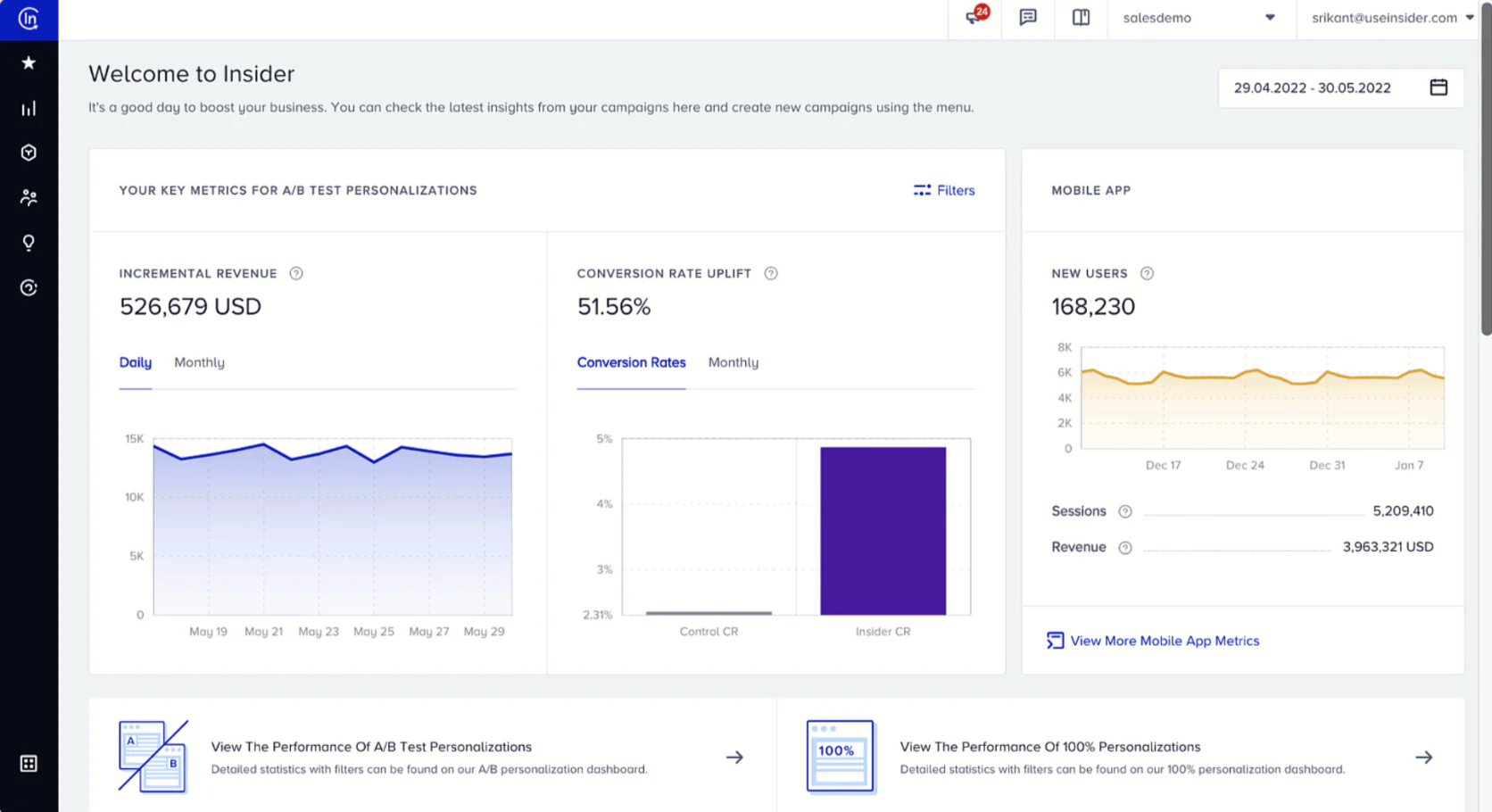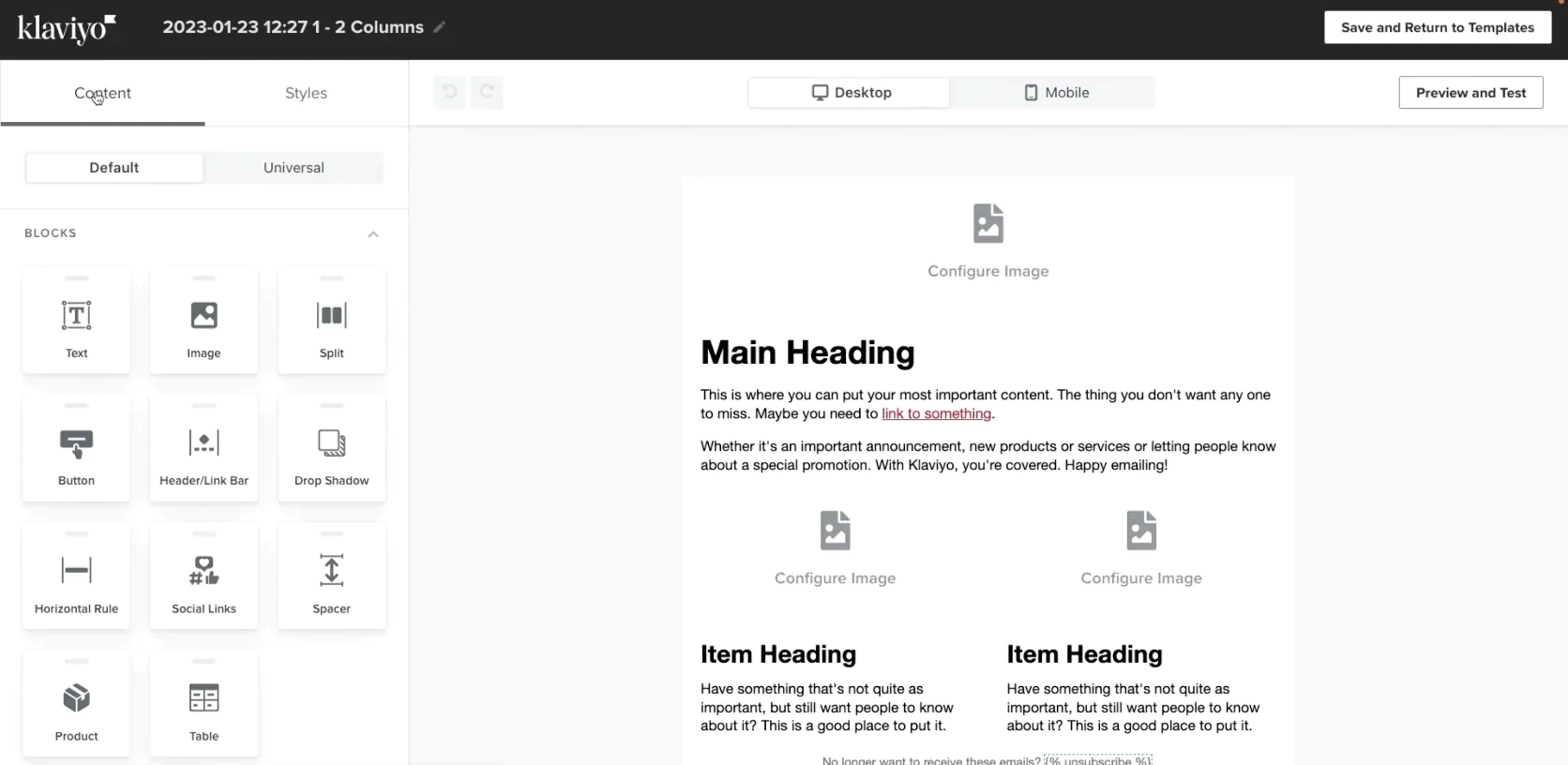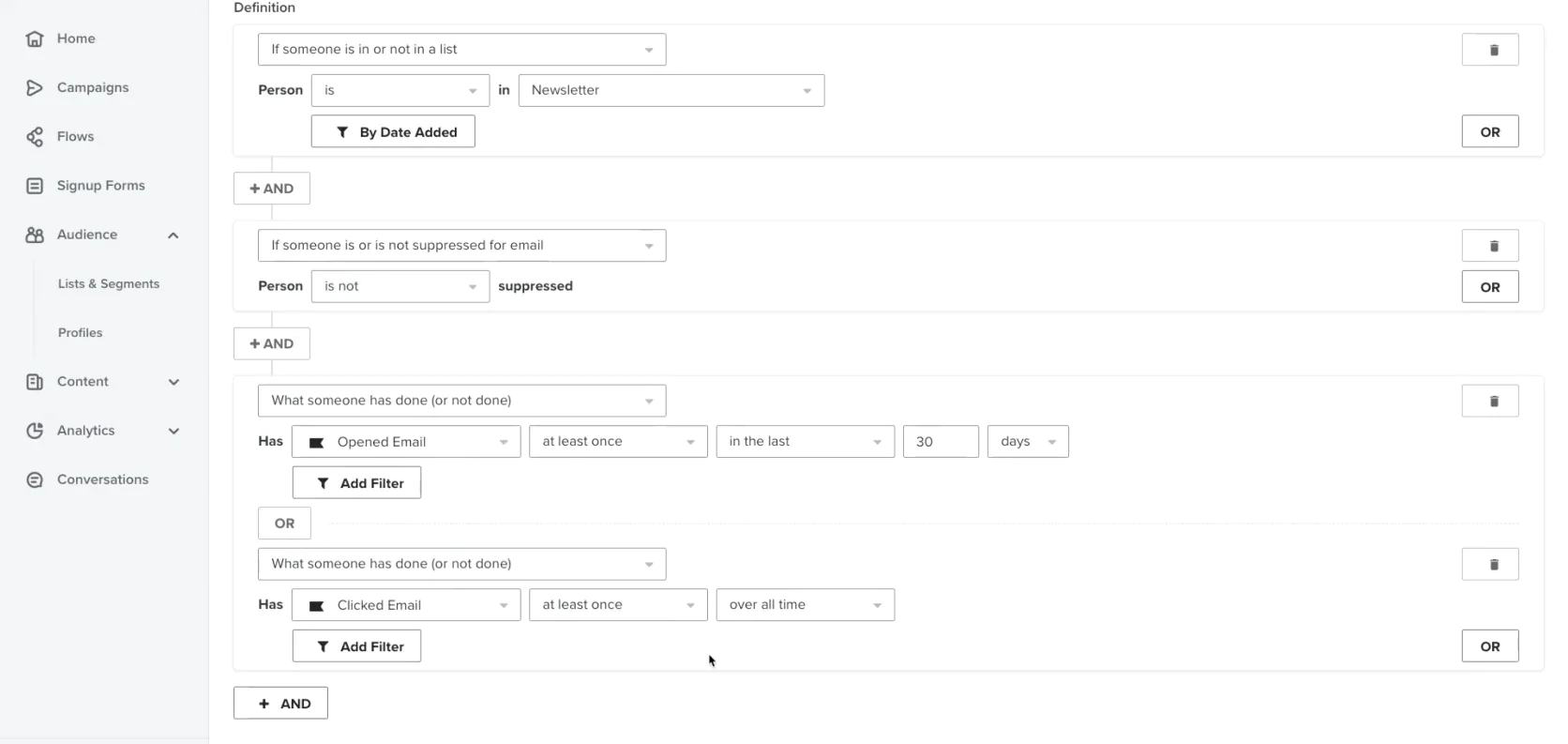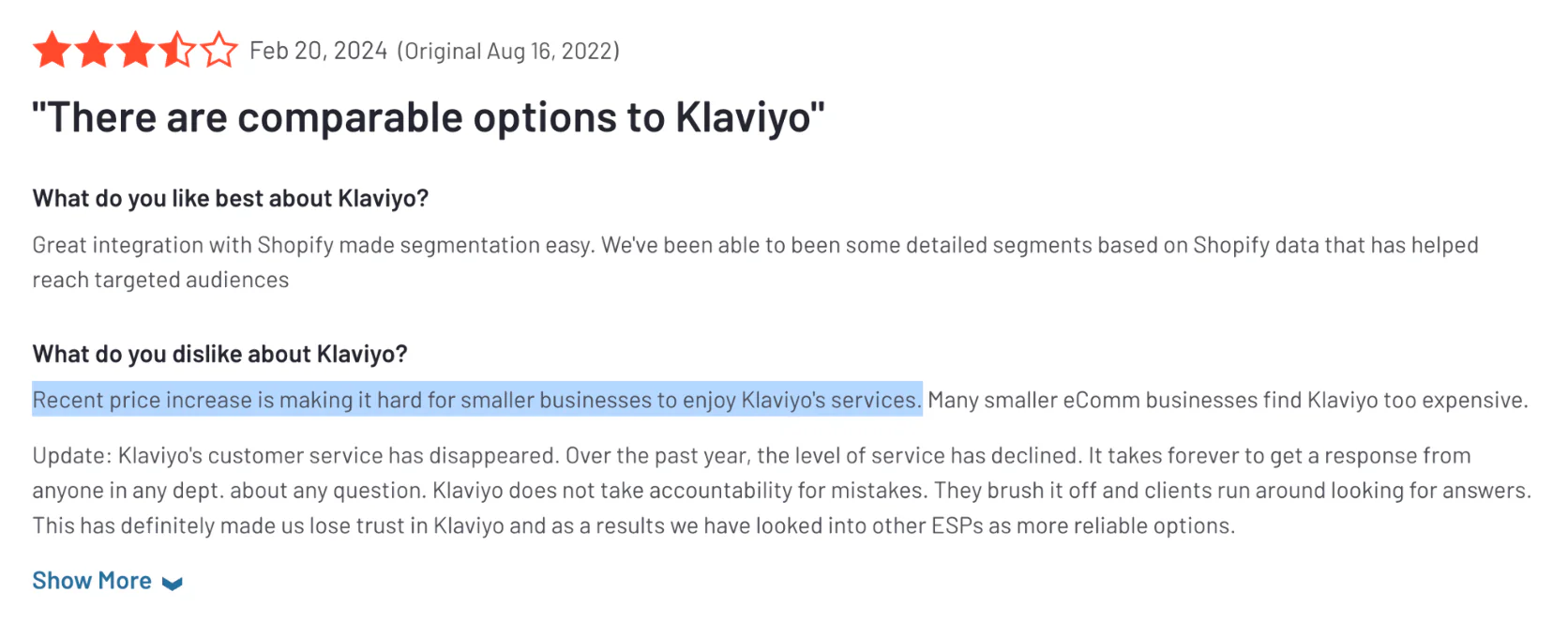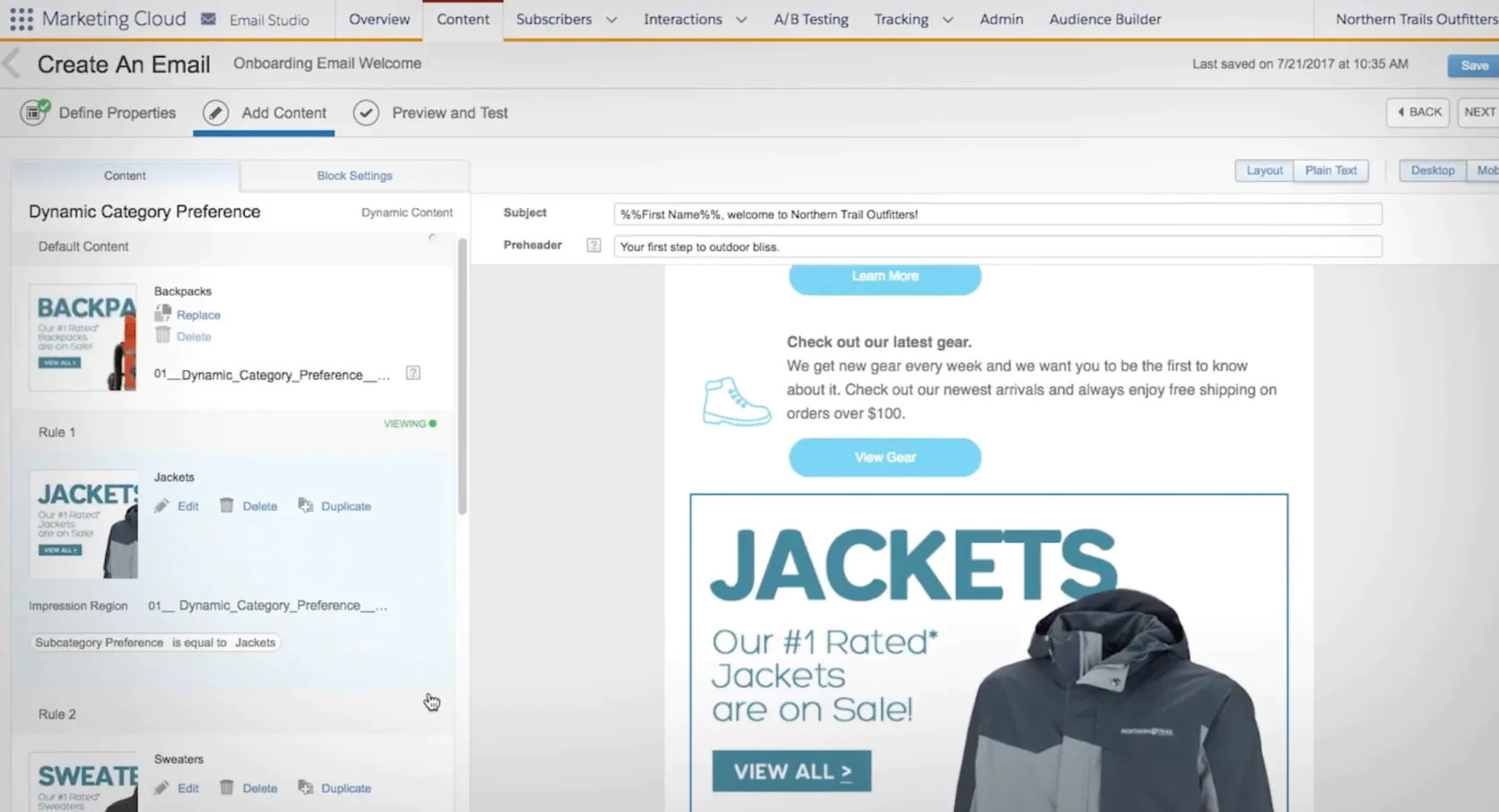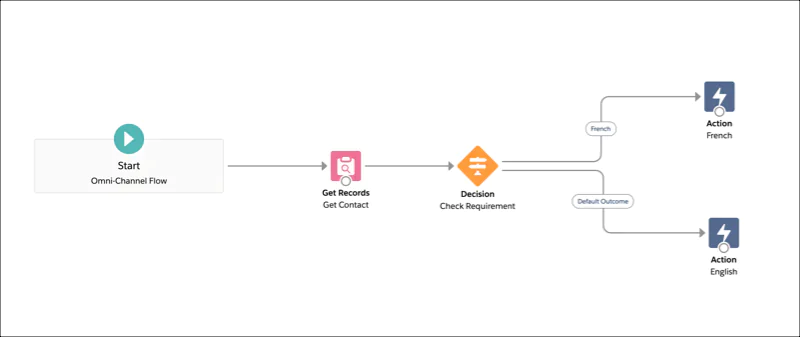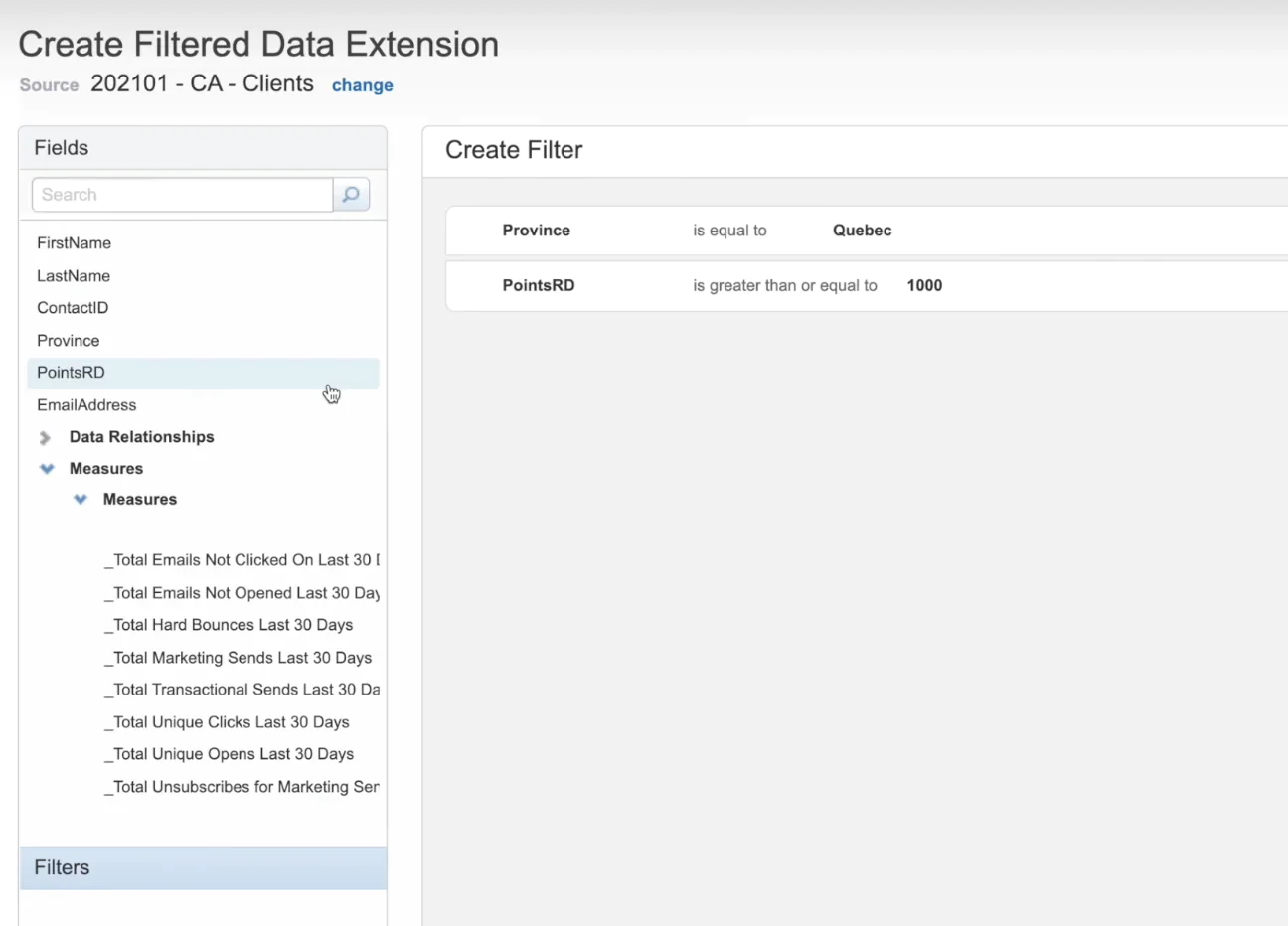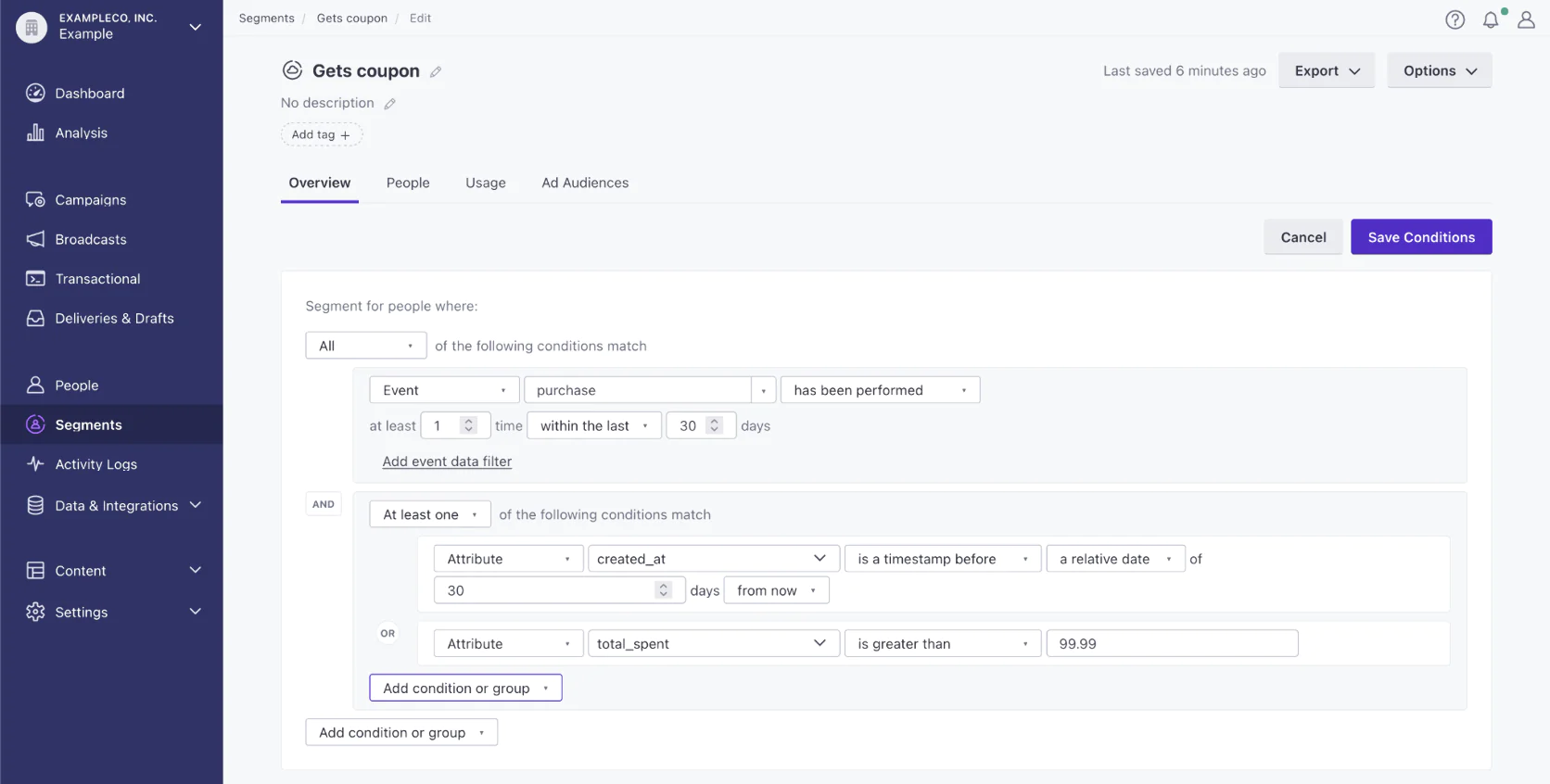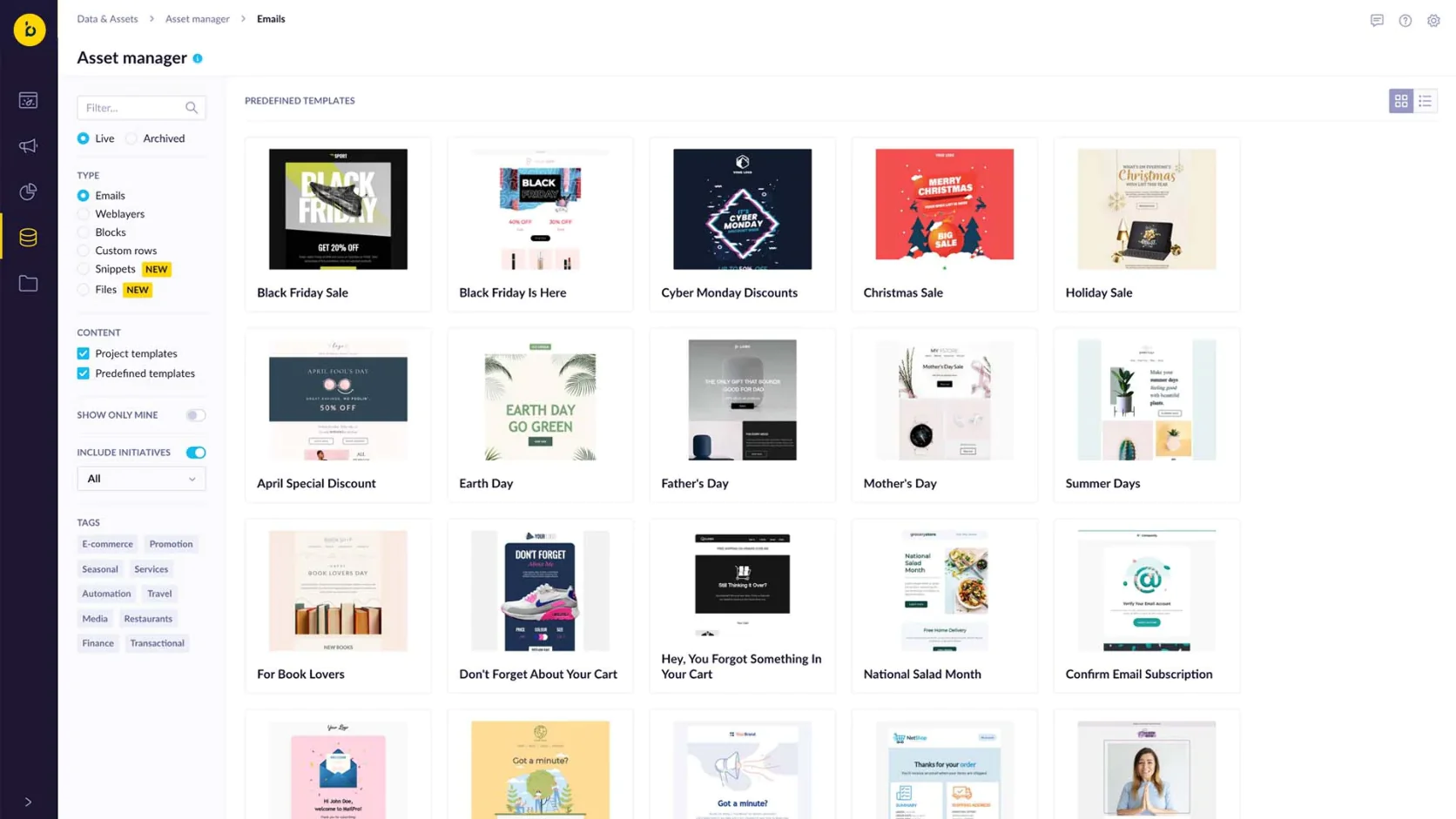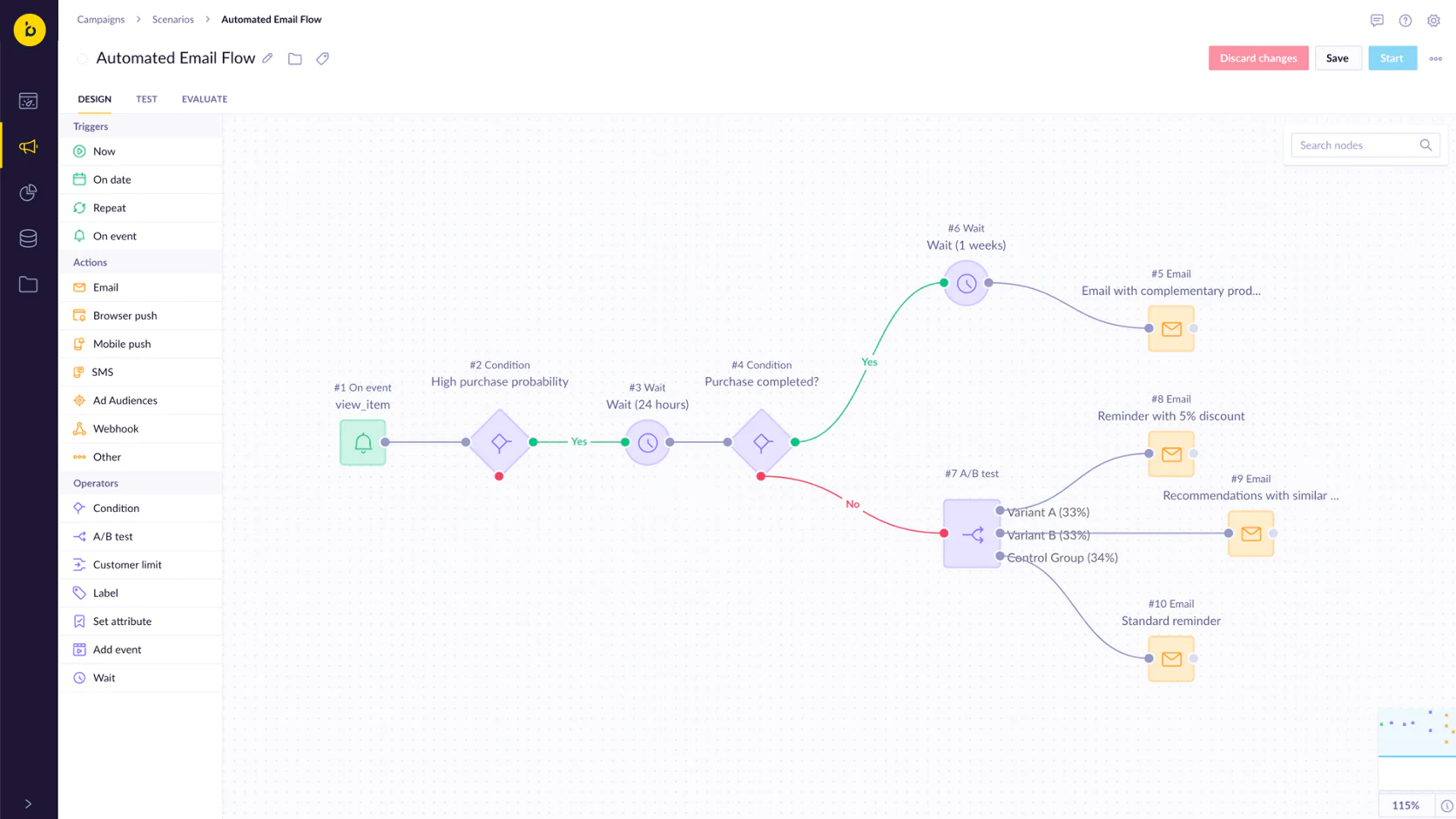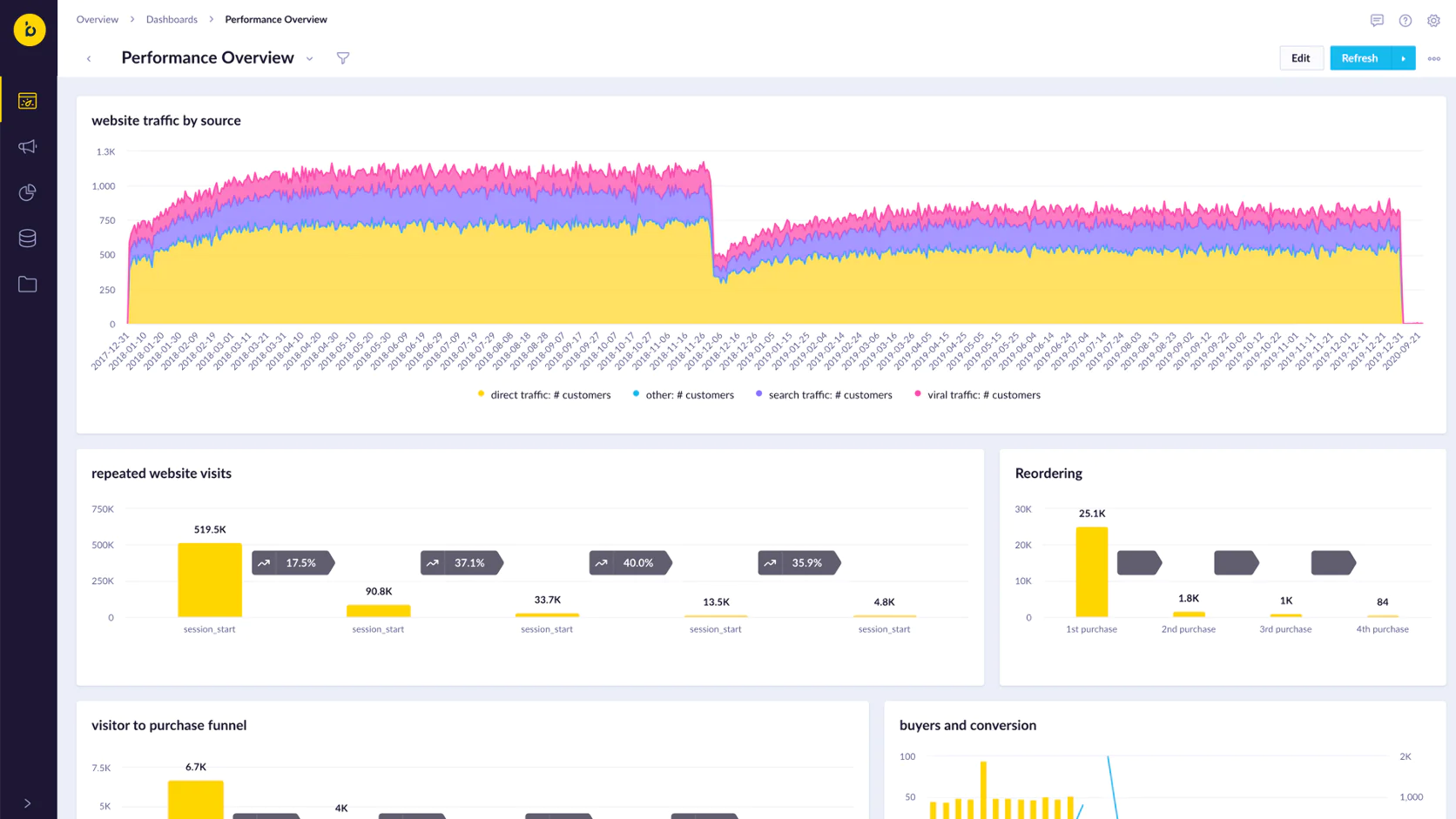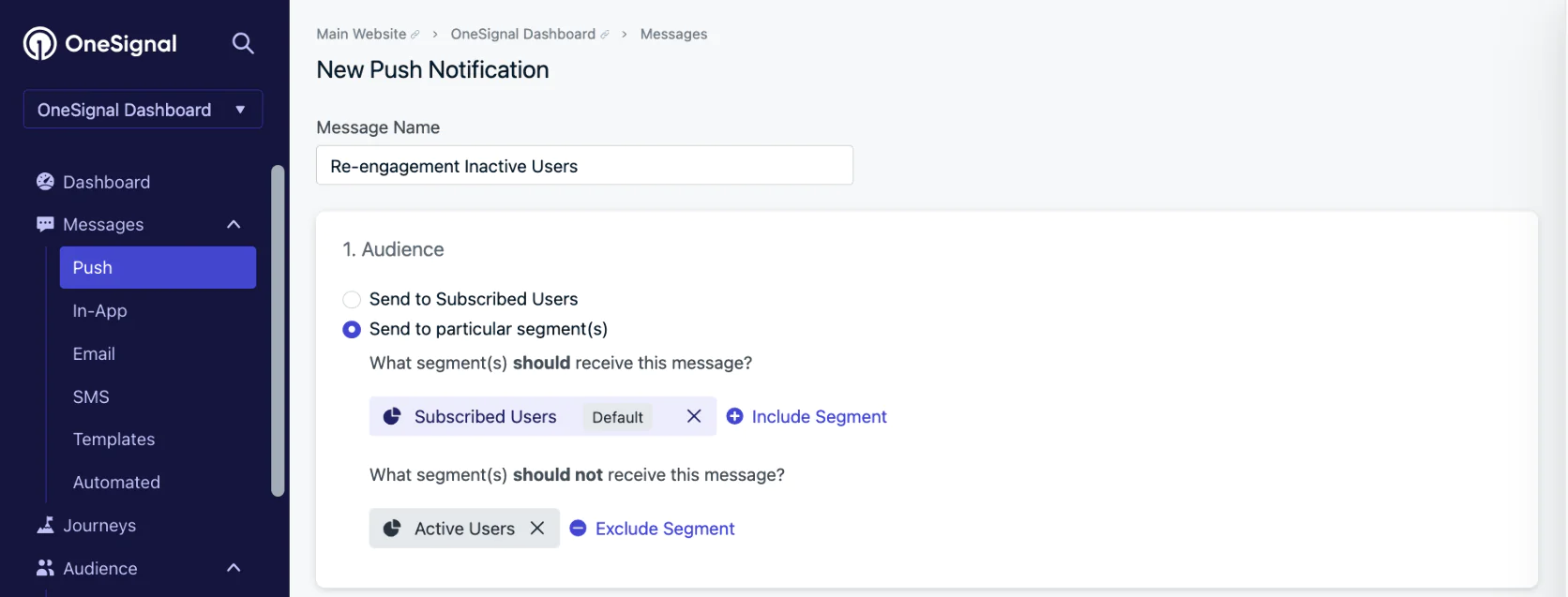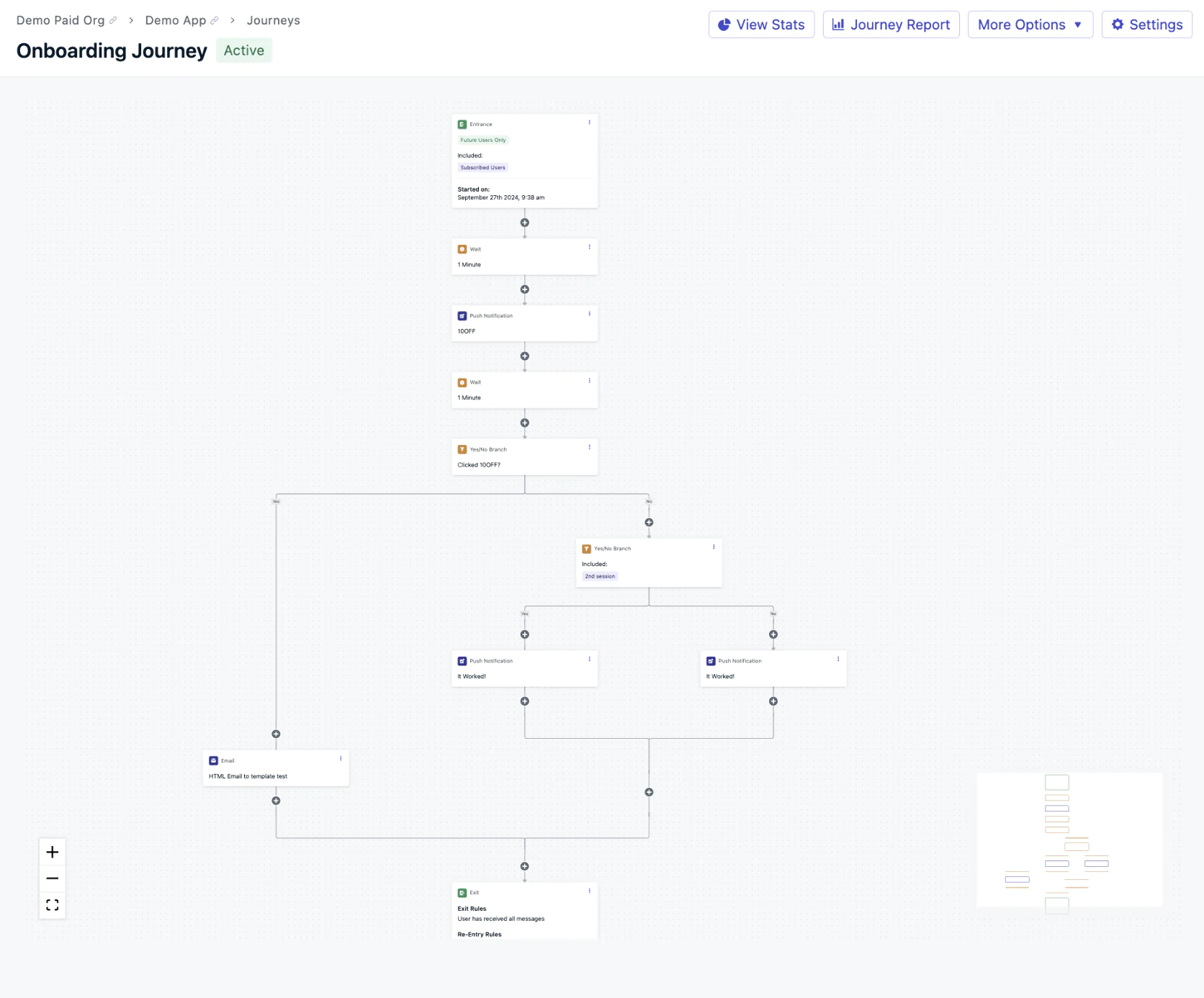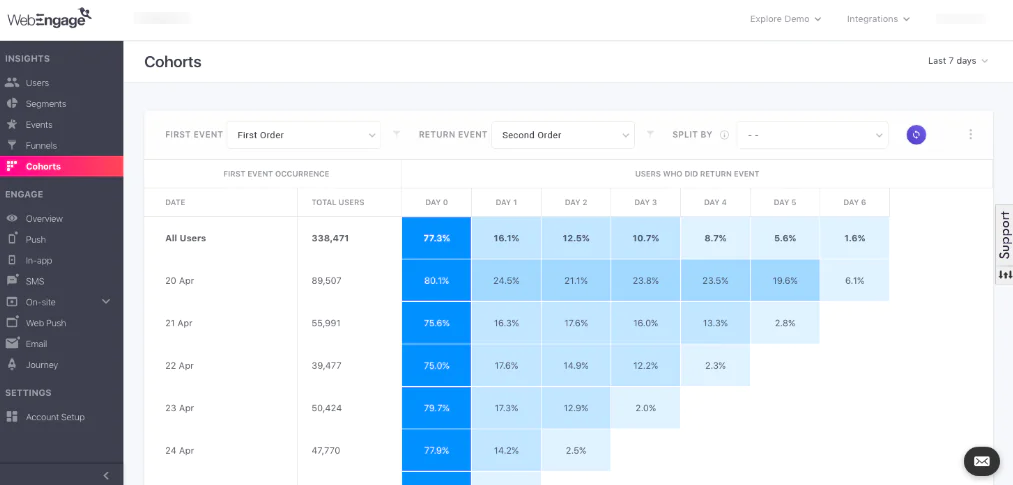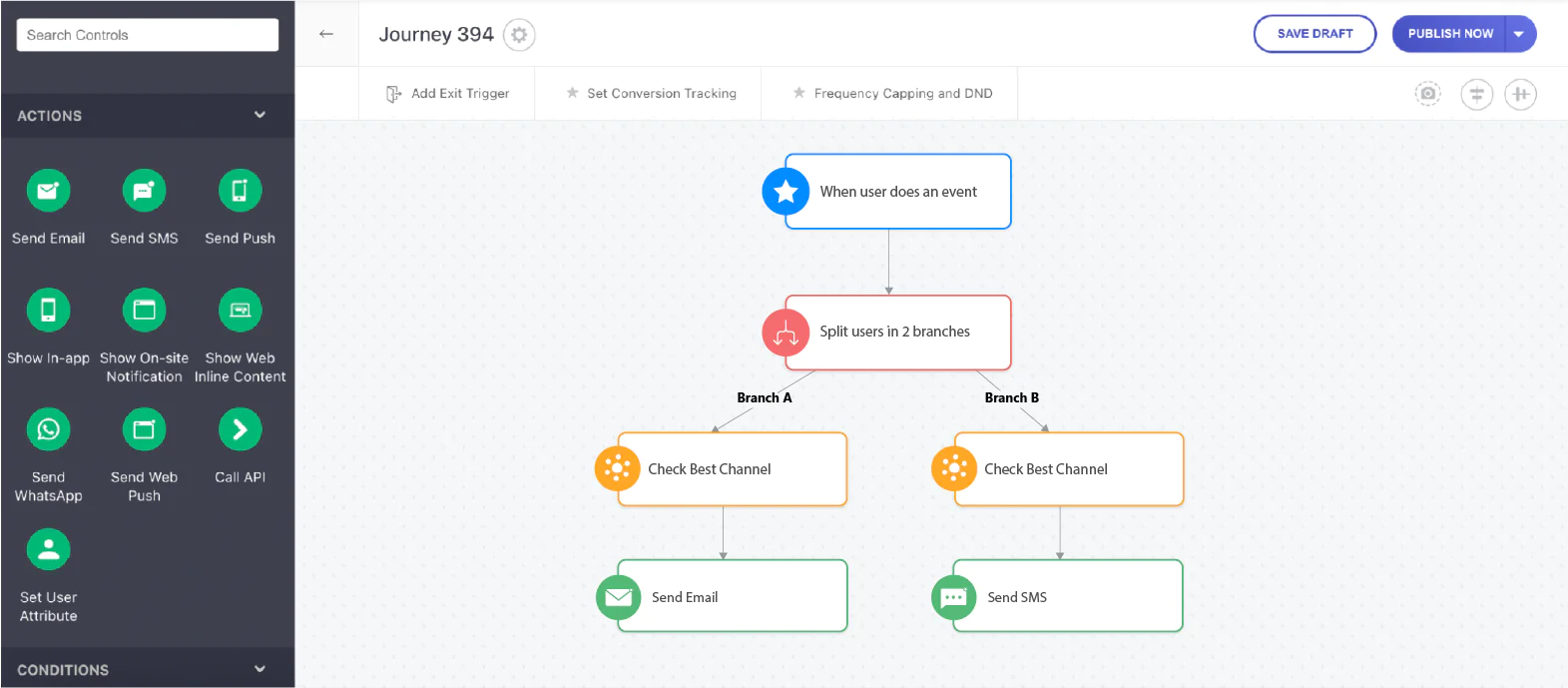11 Best Braze Alternatives: Smarter Customer Engagement Across Channels
Managing multi-channel customer engagement can feel like juggling flaming torches. Email campaigns, push notifications, SMS blasts, in-app messages—drop one, and you risk losing your audience’s attention. Braze has emerged as a leading platform to coordinate this juggling act. It’s a powerful customer engagement hub that enables personalized messaging across mobile apps, websites, email, SMS, and more, all driven by real-time data. Many fast-growing brands rely on Braze to build fully orchestrated customer journeys and deliver the right message at the right time on the right channel.
Yet Braze isn’t a one-size-fits-all solution. Some teams find its enterprise-level complexity and costs challenging. Braze’s rich feature set comes with a steep learning curve and a price tag typically ranging from tens of thousands to six figures per year. It also lacks certain out-of-the-box capabilities that e-commerce marketers crave—for example, there’s no built-in loyalty program or on-site personalization module, meaning you’d need additional tools for those functions. Smaller businesses or those without dedicated technical resources might struggle to harness Braze’s full potential. These are key reasons many businesses seek alternatives.
In this article, we break down 11 top Braze alternatives. Some will save you money; others add capabilities Braze doesn’t offer. We’ll compare each platform on features, pricing, ease of use, and support to help you find the best fit.
Braze is a widely used customer engagement platform that’s gained traction for its focus on omnichannel marketing. It’s designed for marketers looking to manage email, SMS, push notifications, in-app and web messaging, and WhatsApp in one platform.
Braze is particularly well known for some key features and functionality:
Omnichannel Marketing: Braze is built for cross-channel communication, letting businesses manage multiple customer touchpoints. This centralized approach helps maintain consistency across channels.
Braze’s Canvas tool is its standout feature, allowing marketers to design campaigns visually, run A/B tests, and build triggered workflows. The platform’s targeting capabilities support precise audience segmentation, enabling messages based on customer behavior, location, or actions in real time.
Real-Time Data Processing: Braze processes data in real-time, enabling businesses to trigger timely campaigns based on user actions. This is important for the seamless operation of flows, such as onboarding journeys or abandoned intent.
Advanced Segmentation: The platform allows detailed audience segmentation based on user behavior and preferences.
Creating a segment in Braze
But Braze is not without pain points. These include:
Braze also typically provides dedicated account managers only to its largest customers, so smaller clients may get standard support channels.
Pricing Complexity: There’s no free tier, and pricing is quote-based, often starting around $60k+ per year for even modest use cases. This puts it out of reach for many startups and mid-market companies, especially those with only basic messaging needs.
Braze’s pricing model is opaque, with additional fees for certain features. This unpredictability can frustrate businesses trying to stay on budget.
Mobile-Heavy, Web-Light: Braze prioritizes mobile features like SMS and push notifications but doesn’t offer as robust functionality for web channels. For example, their drag-and-drop email builder is often said to need improvement. Plus, loyalty programs or on-site product recommendations aren’t part of Braze—you’d need separate solutions for those, adding complexity to your stack. For brands aiming for a balanced omnichannel approach, this imbalance can be limiting.
APIs and Integrations: If you need a simple integration with Shopify, you shouldn't face any issues. However, more complex integrations will require significant development involvement. Clients often face challenges such as API rate limits and data syncing issues, which delay their projects and cause a lot of frustration. There are also complaints about imperfect documentation and a slow support service.
Reporting Limitations: Braze's reporting tools often fall short. Among the issues are limited timeframes for metrics and a lack of detailed reporting in some areas. For example, to access in-depth reporting on general email statistics, you would need to export your data to an external BI/Analytics solution.
User Interface Issues: Some users find the UI outdated and less intuitive than other modern marketing platforms, which can hinder ease of use. Particularly concerning are the reviews about Canvas: a complex interface can make launching omnichannel campaigns, especially advanced ones, more difficult and time-consuming. Smaller teams may find the interface and myriad options overwhelming.
Bottom line: Braze is a powerful cross-channel marketing hub suited for mature, data-rich teams—but its cost, complexity, and feature gaps (for things like loyalty or web personalization) mean it’s not ideal for everyone. If you’re feeling the pinch with Braze or evaluating your options, the good news is there are plenty of alternatives. Below, we’ve assembled a comparison of Braze and its top competitors, followed by in-depth looks at each.
To set the stage, here’s a quick comparison of Braze, Maestra, and other leading customer engagement platforms. We’ll compare their key features, pricing, ease of use, and customer support at a high level:
Braze
Enterprise Cross-Channel
• Multi-channel messaging (push, email, SMS, in-app, web)
• Advanced real-time segmentation & personalization
• Powerful journey orchestration and analytics
Enterprise pricing (custom quotes, typically $60k+ per year)
Steep learning curve (complex for new users)
Standard support; dedicated success team only for largest clients.
Maestra
All-in-One Marketing Platform
• Omnichannel automation (email, SMS, push, on-site personalization)
• Built-in loyalty & promotions engine
• Real-time CDP for unified customer data
• AI-driven product recommendations
Plans from $2,990/month (flat rate with full feature access)
User-friendly interface; designed for marketers with minimal coding
High-touch support—includes a dedicated Customer Success Manager for each client (on all plans).
Iterable
Cross-Channel Automation
• Cross-channel campaigns across email, mobile, SMS
• Flexible data integrations and APIs
• Strong segmentation & personalization
• Collaborative workflow builder
Pricing on request (enterprise-level, similar to Braze)
Intermediate—slightly easier onboarding than Braze, but still complex
Dedicated support for enterprise clients; generally well-regarded, with better support ratings than Braze.
CleverTap
Mobile Analytics & Engagement
• Mobile-first engagement with in-app & push focus
• AI-powered segmentation (Clever AI) & predictive analytics
• Real-time user behavior database (TesseractDB)
• Omnichannel: push, email, SMS, web, WhatsApp
Tiered plans; Essentials from ~$75/month (up to 5k MAUs); higher tiers custom priced
Moderate—offers no-code tools, but full capabilities require learning curve
Account manager on high tiers; basic plans get standard support (email/community).
Insider
AI-Powered Personalization
• AI-native platform with integrated CDP
• Individualized cross-channel experiences (web, app, email, SMS, WhatsApp, etc.)
• Strong personalization & product recommendation engine
• Proven ROI for enterprise (Gartner & G2 leader)
Сustom enterprise pricing (premium solution for large B2C brands)
Intermediate—modern UI but geared to enterprise needs (some complexity)
High-touch enterprise support with consulting; known for proactive customer success.
Klaviyo
E-commerce Email & SMS
• Email/SMS automation tailored for online stores
• Plug-and-play integrations with e-commerce platforms (Shopify, etc.)
• Easy segmentation based on purchase behavior
• User-friendly campaign builder and templates
Free plan (up to 250 contacts); paid plans from ~$20/month, scaling by contact count
Very easy to use (built for non-technical marketers)
Email and chat support for all paid tiers; no dedicated CSM for small accounts.
Salesforce Marketing Cloud
Enterprise Marketing Suite
• Comprehensive marketing suite (email, mobile, social, ads, web)
• Deep Salesforce CRM integration for 360° customer view
• Powerful segmentation and analytics
• Highly extensible via Salesforce ecosystem
Premium pricing (~$1,500–$3,250/month for mid-tier packages); enterprise contracts common
Difficult—steep learning curve, often requires certified specialists
24/7 support on enterprise plans, plus extensive partner network; support can be slow without a dedicated SFMC expert.
As the table suggests, Braze is not your only choice for customer engagement. In fact, depending on your business size, budget, and feature needs, another platform might serve you better. Next, we’ll dive into each alternative in detail—starting with why Maestra leads the pack as the best Braze alternative.
Maestra—The Best Braze Alternative
Maestra is an all-in-one marketing platform that has quickly become a top choice for brands wanting to streamline customer engagement. What makes Maestra special is its holistic approach: it combines the multi-channel messaging capabilities you’d expect (email, SMS, push notifications, etc.) with built-in tools that typically require additional software.
Out of the box, Maestra includes a real-time Customer Data Platform (CDP) for advanced segmentation, an integrated loyalty and rewards program, a promotions engine for dynamic discounts, and on-site personalization features (like product recommendations and tailored web content). In other words, it’s not just a messaging tool—it’s a full-funnel customer engagement and retention suite.
Some of Maestra’s standout features include:
Omnichannel Automation: Orchestrate campaigns across email, SMS, web, and mobile from one dashboard. For example, you can create a journey that sends an email, follows up with an SMS, and then shows a personalized website banner—all based on real-time customer behavior.
Maestra’s flow example includes emails, mobile and web pushes, pop-ups, paid ads and loyalty points
Real-Time CDP and Segmentation: Maestra’s CDP unifies customer data (online and offline) and lets you segment customers with extreme granularity (down to individual pageviews or purchase history). This fuels hyper-personalized campaigns.
Loyalty & Referral Programs: Unlike Braze, Maestra has native loyalty program management. You can reward customers with points, tiered VIP status, referrals, etc., without needing a separate loyalty platform. This keeps your loyalty data and messaging in one place.
Website Personalization: Maestra can dynamically change on-site content for each user. For instance, you can greet returning customers by name, showcase products related to their browsing history, or trigger pop-ups with tailored offers—all powered by Maestra’s AI personalization engine.
Maestra’s pop-up form templates
Promotions Engine: Easily create and distribute promo codes, discounts, and special offers targeted to specific segments. Maestra can automatically apply these in campaigns and even limit redemptions or set expirations, simplifying campaign management for marketers.
Dedicated Support: Every Maestra client is paired with a dedicated Customer Success Manager to assist with onboarding, strategy, and technical integration—a level of support rarely offered by other platforms at this price point.
In short, Maestra aims to be a one-stop shop for customer engagement. Brands using Maestra don’t have to patch together separate tools for email, SMS, push, loyalty, and personalization—they get it all in one unified system. This integration not only saves cost and hassle, it also means all your customer interactions and data live in one place, unlocking more effective segmentation and consistent messaging.
Compared to Braze: Maestra covers much of Braze’s core functionality in cross-channel messaging and automation—but it goes further by including the e-commerce-centric features Braze lacks (loyalty, promo management, onsite personalization). For example, if you previously used Braze for messaging plus a separate loyalty platform and a separate personalization tool, Maestra can replace that entire stack with a single solution.
This all-in-one approach also makes Maestra easier to implement and use. There are fewer integrations to manage, and the interface is designed for marketers to handle tasks without needing constant developer support.
Maestra’s pricing is transparent and often substantially lower than Braze’s enterprise cost (starting around ~$36k/year for Maestra vs. $60k+ for Braze in many cases).
Finally, Maestra’s dedicated success managers mean even mid-sized clients get a high level of guidance—whereas Braze reserves such white-glove support for its biggest enterprise customers.
Compared to other competitors: Maestra manages to blend strengths that usually belong to different platforms.
It offers enterprise-grade capabilities similar to Braze and Iterable (robust multi-channel automation, scalability) while maintaining the user-friendliness of platforms like Klaviyo that cater to smaller teams. Maestra’s built-in loyalty and personalization give it an edge over virtually all competitors: for instance, Klaviyo lacks on-site personalization or loyalty features, Iterable and Customer.io focus on messaging and require add-ons for loyalty, and even Insider—known for AI personalization—doesn’t include a native loyalty program.
In essence, Maestra is carving out a niche as the most comprehensive solution, ideal for mid-market and enterprise brands (especially in e-commerce) that want to drive growth without assembling a patchwork of tools. If you value having everything in one platform and being supported by a team that will help you succeed, Maestra is tough to beat.
Maestra is particularly well-suited for e-commerce and direct-to-consumer brands that have outgrown basic email tools but find enterprise suites like Braze or Salesforce overkill. It gives these brands advanced capabilities (real-time data, multi-channel reach, sophisticated targeting) in a more accessible package. Many companies ready to “graduate” from Klaviyo or Mailchimp choose Maestra to avoid the complexity of Braze.
Overall, if you’re looking for a Braze alternative that checks all the boxes—omnichannel messaging, single customer view, loyalty, personalization, and stellar support—Maestra should be at the top of your list.
Iterable—Enterprise Cross-Channel Marketing Automation
Iterable is often mentioned in the same breath as Braze, and for good reason. It’s a powerful cross-channel marketing automation platform that enables companies to create coordinated campaigns across email, mobile push, SMS, in-app messaging, and more.
Iterable’s visual email composer
Iterable offers a highly flexible data model and APIs, making it a favorite for companies that want to plug in their own data sources or custom integrations. Its campaign builder is marketer-friendly and supports complex branching journeys similar to Braze’s Canvas. Iterable also excels in personalization, with features like data feeds to pull in dynamic content and a catalog for product recommendations.
Iterable: user segmentation
Compared to Braze: Iterable’s capabilities are quite similar to Braze—in fact, many enterprise teams evaluate both. Both platforms handle real-time triggers, multi-step journeys, and granular segmentation.
One notable difference is ease of implementation: Iterable is often cited as being a bit easier to set up and work with than Braze, and its customer support tends to rate higher in responsiveness. Users report that Iterable is slightly more straightforward for new teams to get started (Braze can require more solution engineering up front).
Iterable: сreating push notification
However, Braze may have an edge in certain areas like built-in support for in-app messaging out of the box and some of its analytics depth. Cost-wise, Iterable is still an enterprise solution—there’s no public pricing, and it can be as expensive as Braze in practice.
Compared to Maestra: Iterable covers the core messaging channels similar to Maestra and Braze, but it does not include extras like loyalty programs or web personalization. If you went with Iterable, you might still need additional tools for loyalty or on-site targeting, whereas Maestra would have those built-in.
Iterable is a strong choice for organizations that primarily need a messaging and automation engine and perhaps have an in-house data team to maximize it. But for a marketing team that wants more features under one roof (and more hands-on support), Maestra might deliver more value.
In summary, choose Iterable over Braze if you want Braze-like power with (slightly) less complexity, and consider Maestra if you want that power plus more comprehensive marketing features.
CleverTap—Insights-Led Mobile Engagement
CleverTap is an all-in-one customer engagement and retention platform with a strong focus on mobile apps. If your business centers around a mobile app and you need advanced in-app engagement and analytics, CleverTap is a leading option.
It stands out for its investments in AI and predictive analytics. For example, CleverTap’s proprietary Clever.AI engine can analyze user behavior and help predict churn or conversion likelihood, enabling marketers to automate highly targeted campaigns.
Creating an email with Clever.AI’s recommendations
Another unique component is TesseractDB, CleverTap’s fast big-data store that captures enormous volumes of user events (even into the millions per user) for analysis. With these, CleverTap offers features like automated segmentation, personalized product recommendations, and A/B testing, all geared toward boosting retention and lifetime value in app-driven businesses.
On the messaging side, CleverTap supports omnichannel outreach as well—not only mobile push and in-app messages, but also email, SMS, web notifications, and even WhatsApp. The platform provides a visual journey builder so you can design campaigns that, say, send a push notification if a user doesn’t open an email, etc. Marketers who prefer a no-code or low-code approach will appreciate CleverTap’s interface for creating campaigns and experiments without needing to write queries.
Compared to Braze: CleverTap is often seen as a Braze alternative for mobile-centric companies. It offers many of the same messaging channels and automation features as Braze.
Where it differentiates is analytics—CleverTap’s insights-led approach (with features like funnels, cohorts, and predictive scoring baked in) can provide deeper understanding of in-app user behavior out of the box. Braze has analytics too, but CleverTap’s are especially tuned for product teams and growth marketers.
Additionally, CleverTap’s pricing can start much lower than Braze’s for small volumes (they even advertise an entry tier around $75/month for up to 5k users), making it more accessible to startups. That said, as your user count grows, costs will scale, and enterprise plans become custom (potentially hefty) as well.
One trade-off is that Braze’s interface might be more polished for cross-channel campaign building, whereas CleverTap’s strength is data science.
Compared to Maestra: CleverTap and Maestra have different philosophies. CleverTap is great for mobile app engagement and granular behavioral analytics. Maestra, on the other hand, is built for e-commerce and omnichannel marketing with a focus on unifying channels and adding loyalty/personalization features.
If you mainly need to engage app users and want AI-driven insights to inform your campaigns, CleverTap is a top choice. But if you need a broader marketing solution (covering web, email, SMS equally as strongly as push), or you want built-in loyalty mechanics, Maestra would have the upper hand.
In short: pick CleverTap for mobile-first growth and rich analytics, or Maestra for a more all-encompassing marketing suite that’s tuned to retail/e-commerce use cases as well.
MoEngage—Insights-Led Customer Engagement
Like CleverTap, MoEngage is an “insights-led” customer engagement platform popular among mobile-first and digital brands. In fact, MoEngage and CleverTap are direct competitors often compared side by side.
MoEngage enables personalized messaging across multiple channels—push notifications, in-app, email, SMS, web—and emphasizes helping brands understand users through 360° customer analytics. Its platform is built for marketers and product owners who “value agility over cumbersome complexity”, which hints at an easier learning curve than some enterprise tools.
Key features of MoEngage include a robust segmentation engine (to create fine-tuned audiences based on behavior), journey orchestration for cross-channel campaigns, and a good range of out-of-the-box AI features (like predictive churn modeling and recommended campaign send times).
MoEngage’s push notification click propensity
It also provides an App Marketplace of pre-built integrations, making it simpler to connect MoEngage with other tools or data sources in your stack.
MoEngage’s App Marketplace
Compared to Braze: MoEngage is often chosen by companies that find Braze too complex or expensive for their needs. MoEngage tends to be more cost-effective (they have published plans for smaller businesses, whereas Braze does not) and can be easier for a lean team to adopt.
It still offers rich functionality, but customers often mention MoEngage’s more responsive support and onboarding as a plus. On the flip side, Braze is a bit more established among very large enterprises; if you require ultra high-volume throughput or have very engineering-driven requirements, Braze’s platform and documentation might edge out MoEngage.
That said, MoEngage has been rapidly innovating and is featured in industry reports alongside Braze as a leader in multi-channel marketing. It’s a solid Braze alternative for those seeking similar capabilities with a friendlier price and interface.
Compared to Maestra: MoEngage’s scope is closer to Braze and Iterable—focusing on messaging and automation—whereas Maestra includes more marketing functionalities (loyalty, on-site personalization, etc.). If you need those extras, MoEngage would require supplementing with additional tools.
Maestra could also be more tailored if you’re specifically in e-commerce, offering built-in integrations for storefronts and customer loyalty use-cases that MoEngage doesn’t natively handle.
On usability, both aim to be marketer-friendly; you might trial both to see which UI you prefer. MoEngage could be a great fit for a mobile-focused team that primarily wants to optimize app engagement and is willing to handle things like loyalty separately.
But for a unified solution that covers both acquisition and retention (loyalty) angles, Maestra still has an advantage.
Insider—AI-Powered Personalization Platform
Insider is a bit different from the typical messaging platform—it brands itself as an AI-powered Customer Experience platform and “Growth Management Platform.”
Insider’s customer profile
Insider’s strength lies in delivering highly personalized experiences, backed by an integrated CDP and AI analytics. It enables enterprise marketers to unify customer data across systems, predict behavior with machine learning, and orchestrate individualized journeys across a wide array of channels.
Insider covers channels like web (on-site personalization, overlays), mobile app, email, SMS, web push, and even newer avenues like WhatsApp or Facebook Messenger.
One of its signature features is an AI intent engine that can, for example, predict which product a customer is likely to buy next or which users are at risk of churning, then automatically segment and target those groups.
In practice, Insider often acts as a personalization layer on top of your existing marketing stack, though it also includes campaign capabilities. Retail and travel brands use Insider to personalize homepage content, product recommendations, and messaging timing to each user. The platform comes with many pre-built templates and use-case playbooks (for cart abandonment, churn reactivation, product recommendations, etc.), which can accelerate execution for marketing teams.
Compared to Braze: Insider can overlap with some of Braze’s functionality (e.g., sending emails or push notifications), but its real differentiator is the AI personalization and web experience aspect. Braze is primarily a messaging workhorse; it sends what you tell it to send, when you schedule it.
Insider, in contrast, is more about optimization—deciding who to target and what content to show/send using machine learning insights. For a company already using Braze, Insider might be brought in to enhance personalization. But if one is considering an alternative, Insider could potentially replace Braze’s campaign functions if the primary goal is maximizing personalization.
Keep in mind, Insider is geared towards large enterprises (they tout many Fortune 500 clients) and operates at a similar premium price point as Braze.
Its ease of use is decent for what it does—given the sophisticated tech under the hood, they’ve managed to package it in a way that marketers can utilize.
Compared to Maestra: Insider and Maestra have some overlap (both have a CDP, both do omnichannel messaging), but their focus differs. Insider is the choice if your top priority is predictive analytics across channels—for instance, if you want to deploy machine learning models to segment customers or dynamically change your website for each user. Maestra, while it also offers personalization, shines as an all-in-one marketing solution that covers campaign execution, loyalty, promotions, etc., in a very unified way.
Also, Insider typically doesn’t handle loyalty programs or some e-commerce specifics out of the box, whereas Maestra does.
In summary: large brands with ample budget that want an AI-driven personalization powerhouse might lean toward Insider. Brands that want a more balanced, all-inclusive platform (with solid personalization plus other marketing features) would find Maestra a better fit. It’s worth noting some companies might even use Maestra and Insider together—Maestra as the core marketing platform, and Insider to turbocharge certain AI personalization aspects—but for most, that would be overkill. As an alternative to Braze, choose Insider if you’re aiming to go beyond traditional campaign marketing into AI-led customer experience management.
Klaviyo—Email & SMS Marketing for E-commerce
Fragment of Klaviyo’s business review dashboard
Klaviyo is extremely well-known among e-commerce businesses as the go-to email and SMS marketing platform. It may not have Braze’s multi-channel breadth (Klaviyo focuses mainly on email, SMS, and some simple push or forms integrations), but for many online brands, Klaviyo’s deep integration with e-commerce data makes it a powerful alternative for their needs.
Klaviyo shines in ease of use and rapid ROI: it offers a rich library of templates and automation flows (for welcome series, cart abandonment, post-purchase follow-ups, etc.), which are very plug-and-play. The platform pulls in your store data (products, orders, customer segments from Shopify, Magento, etc.) and allows highly targeted email/SMS campaigns based on purchase behavior and website activity.
Its segmentation is solid (maybe not as real-time as Braze’s, but sufficient for most small/mid businesses), and it recently added features like predictive lifetime value scoring.
Klaviyo’s segment builder
Compared to Braze: Klaviyo is best for small to mid-sized online businesses that want to get going quickly on email/SMS marketing. It is far easier to use than Braze—a marketer can self-service everything in Klaviyo without needing engineers.
The trade-off is capability: Klaviyo is less comprehensive in channels (it doesn’t natively support in-app messaging; push notifications are only via a web push integration, not mobile push unless you do custom work).
It also lacks the advanced journey orchestration across as many channels as Braze; essentially, Klaviyo is optimized for the email/SMS realm.
Another shortcoming is the absence of built-in loyalty or referral programs in Klaviyo. So as your marketing strategy grows, you might find Klaviyo limiting—many companies using Klaviyo eventually add other tools for things like on-site personalization, multi-channel orchestration, or a VIP loyalty club. This can lead to the very “fragmented stack” problem that Braze or Maestra are designed to solve.
In terms of cost, Klaviyo wins for smaller lists (Braze wouldn’t even entertain very small clients), but at large scale, Klaviyo can also get pricey since it charges per contact/message and has no cap—some larger DTC brands end up paying tens of thousands per year on Klaviyo too.
Compared to Maestra: Maestra and Klaviyo appeal to somewhat different stages of business. Klaviyo is excellent for early-stage and small businesses—you get going quickly with professional email campaigns and basic automation. Maestra is targeted at more established brands (often those who may have “graduated” from Klaviyo) that need more channels and features unified.
When directly comparing: Maestra includes everything Klaviyo does (email and SMS marketing with segmentation tied to store data) and then adds more on top (push notifications, a loyalty system, on-site personalization, etc.). If your business is already on Klaviyo and feeling its limits (for example, you want to do in-app messaging for your mobile app, or you want to launch a points-based loyalty program), Maestra is an attractive upgrade that won’t be as intimidating as going to a true enterprise solution like Braze.
Salesforce Marketing Cloud—Enterprise Marketing Suite
Salesforce Marketing Cloud (SFMC) is a heavyweight contender in this space, positioned as a comprehensive enterprise marketing automation suite. It’s part of the broader Salesforce ecosystem, which means it integrates deeply with Salesforce CRM (Sales Cloud and Service Cloud). Companies that already use Salesforce for CRM often consider SFMC to leverage that unified data.
Salesforce Marketing Cloud’s email builder
SFMC is actually a collection of studios/builders (Email Studio, Mobile Studio, Journey Builder, Advertising Studio, etc.), and it’s capable of handling email marketing, SMS, push, social media management, advertising audiences, and more. With SFMC’s Journey Builder, marketers can design very intricate customer journeys similar to Braze’s flows, encompassing multiple channels and decision splits.
Salesforce Marketing Cloud’s Journey Builder
One of SFMC’s strongest points is its data handling and customization—it can tap into Salesforce’s data model, use CRM objects, and incorporate AI via “Einstein” features for things like send-time optimization or predictive scoring.
Salesforce Marketing Cloud: user segmentation
It also offers robust analytics and reporting, especially if combined with Salesforce’s Tableau or Datorama analytics tools. Essentially, SFMC is often used as the central hub for all marketing communications in large organizations, especially those that are B2C and already using Salesforce.
Compared to Braze: Both Braze and SFMC target enterprise use cases, but they come from different angles. Braze started in the mobile/app world and expanded into cross-channel messaging with a focus on real-time, event-driven campaigns. SFMC, on the other hand, evolved from email marketing roots (ExactTarget) and CRM-driven campaigns, excelling at batch and blast as well as scheduled journey campaigns.
Braze might have an edge in real-time responsiveness and a more modern interface for marketers. SFMC has a reputation for being complex and requiring specialized expertise—it’s not uncommon for companies to hire certified SFMC consultants or agencies to run it. In fact, new users often find SFMC’s learning curve quite steep.
In terms of functionality, there’s a lot of overlap; nearly anything you can do in Braze you can configure in SFMC, and vice versa. SFMC’s deep integration with CRM data is a plus if you want sales/service data triggering marketing messages (for example, trigger an upsell email when a sales opportunity closes). Braze, conversely, might integrate that via API but it’s not native.
Pricing for SFMC is also enterprise-grade—they have packages (Starter, Growth, Advanced editions) and typically end up being as expensive, if not more, than Braze for similar scales. SFMC might be part of a broader Salesforce deal, though, which some enterprises find convenient (one vendor for multiple needs).
Compared to Maestra: Maestra’s value prop is simplicity and completeness for marketers, whereas SFMC is almost a toolkit that can be molded to many enterprise needs with enough time and resources.
If you are a large enterprise with a dedicated marketing operations team and already in the Salesforce ecosystem, SFMC can be a powerful Braze alternative. It will integrate natively with your CRM and other Salesforce tools, providing a single source of truth.
However, if you’re not prepared to invest in a lot of training or consulting, SFMC can be overwhelming. Maestra could deliver 80% of what SFMC offers, but in a much more streamlined package that a lean team can handle.
Also, SFMC doesn’t inherently include loyalty program management—Salesforce has a separate Loyalty Management product (part of Salesforce 360) that would need integration, whereas Maestra bakes that in.
For an e-commerce brand that isn’t already tied into Salesforce, choosing SFMC over something like Maestra or Braze would likely be overkill. In summary, SFMC is a viable Braze alternative primarily for very large organizations or those wanting tight CRM alignment. Others will probably find more agility and cost-effectiveness in newer platforms like Maestra or the other tools listed here.
Customer.io—Data-Driven Messaging for Lean Teams
Customer.io is a popular choice for startups and mid-stage companies that need flexible, data-driven messaging without the enterprise bloat. It’s a SaaS platform that lets you send personalized emails, push notifications, and SMS based on what users do in your app or website.
Customer.io: visual email composer
Customer.io is loved by developers and growth hackers because of its flexibility: you can stream behavioral data into it via APIs or Segment, and then build real-time segments and trigger campaigns off that data. It has a visual workflow builder for setting up automations, and it supports advanced conditional logic and A/B testing within messages.
Customer.io’s ad audience management
One of Customer.io’s strengths is that it doesn’t impose a rigid schema—you define the customer attributes and event data that matter to you. This makes it very adaptable to different types of businesses (from SaaS apps to e-commerce to gaming).
It’s also relatively affordable: their pricing is contact-based, and they offer a free tier via their newer Customer.io Data & Messaging product (formerly there was a free tier up to certain contacts/events, which made it accessible to early startups).
Compared to Braze: Customer.io can be seen as a “lighter” Braze. It handles event-triggered messaging quite well, so if that’s your main use case (say, send a welcome email when a user signs up, a reminder push if they haven’t used the app in 7 days, etc.), Customer.io can accomplish it at a fraction of Braze’s cost.
It’s also generally easier to implement—developers can integrate it in a day or two, and the UI is straightforward for marketers to create campaigns. However, Customer.io is not as feature-rich at scale. For example, while it has segments and conversions, it might lack some of Braze’s deeper analytics dashboards or AI features.
Customer.io: user segmentation
It also supports fewer native channels (Customer.io added push and SMS, but Braze has in-app messages, Content Cards, and more out-of-box channel types). For a lean growth team, though, those differences may not matter.
Customer.io also has a smaller company support vibe—many users praise their support and documentation, whereas Braze’s support might feel more distant unless you’re a big client.
The flip side is Braze is battle-tested for massive scale (millions of users, complex orgs), while Customer.io is ideal when you’re at tens or hundreds of thousands of users and want agility.
Compared to Maestra: Customer.io and Maestra target somewhat different customers. Customer.io appeals to tech-savvy teams who want a flexible messaging tool they can plug into their own data pipelines. Maestra appeals to marketing teams who want a more complete out-of-the-box solution with a broad set of marketing features (and the support to go with it).
For instance, Customer.io won’t give you a loyalty program or a drag-and-drop email template builder filled with content blocks—it’s a bit more bare-bones, expecting you to craft your emails and logic with its tools. Maestra provides more ready-made marketing components and a concierge approach (dedicated CSM, etc.).
If you have the engineering resources and only need a solid messaging/automation core, Customer.io is a cost-effective alternative to Braze. But if you prefer a platform that covers more marketing functions without custom dev work, Maestra would serve you better. Many businesses might start with Customer.io to get their feet wet in automated messaging and later upgrade to a platform like Maestra or Braze as they grow and require more integrated features.
Bloomreach Engagement (Exponea)—Data-Powered Omnichannel Marketing
Bloomreach Engagement—formerly known as Exponea before being acquired and rebranded by Bloomreach—is a robust customer data and omnichannel marketing platform. It combines a CDP, advanced segmentation, campaign orchestration, and AI-driven personalization, specifically with a focus on retail and e-commerce.
Bloomreach’s asset manager
Bloomreach as a company is unique because it offers other modules like site search and CMS (content management) in addition to the marketing automation piece (that’s the “content, search, and merchandising” combination).
But focusing on Bloomreach Engagement: it allows marketers to run campaigns across email, SMS, web, mobile, and more, all fueled by a unified customer profile and real-time data analysis. Exponea (Bloomreach) was known for its strong analytics and revenue attribution—you can drill down into funnels, retention reports, segment analyses within the tool, and then quickly turn those insights into campaigns.
Bloomreach’s flow builder
A major selling point is its AI recommendations and personalization. Similar to Insider, Bloomreach can personalize on-site content or emails with product suggestions based on user behavior, and it has a library of pre-built machine learning algorithms for things like next best product or likelihood to purchase. It’s designed so that a marketing team (with perhaps a data analyst on hand) can run sophisticated lifecycle campaigns without needing a lot of IT support.
Compared to Braze: Exponea/Bloomreach Engagement was often pitched as an all-in-one alternative to Braze + a CDP + a personalization engine. It offers comparably strong cross-channel campaign features to Braze, but with a heavier emphasis on data analysis and e-commerce use cases.
Braze has an edge in immediate real-time triggering and perhaps ease of use for pure campaign setup. Bloomreach might require more initial configuration to set up tracking and schema (since it’s also a CDP), but then it pays off by having all your events and attributes available for analysis.
In terms of results, companies that chose Exponea over Braze often did so because they wanted to quickly action insights on customer data within one tool—essentially combining analytics + campaigns. With Braze, you often integrate an external analytics solution.
Bloomreach’s Performance Overview dashboard
Pricing-wise, Bloomreach Engagement is enterprise software too, usually a yearly SaaS license often in the same ballpark as Braze. If you are very ROI-focused and want to measure every campaign’s revenue impact inside the platform, Bloomreach is attractive. If you simply need to send messages at scale reliably, Braze is a proven option.
Compared to Maestra: Maestra and Bloomreach both appeal to digital commerce brands and have overlapping capabilities (CDP, multi-channel messaging, personalization). One difference is Bloomreach is part of a larger suite that can include e-commerce search and content management—if you want one vendor for both your marketing automation and perhaps your website product discovery engine, Bloomreach can do that. Maestra sticks to marketing and retention exclusively.
From a usability standpoint, Maestra might be easier for pure marketers, whereas Bloomreach, being very data-rich, might be leveraged best by a team that includes data analysts or CRM specialists.
Both have loyalty use-case coverage, but Maestra’s dedicated loyalty engine could be simpler if loyalty is a priority (Bloomreach can manage loyalty logic but it might not be as plug-and-play).
In short, Bloomreach Engagement is a strong Braze alternative for data-driven marketing teams that want an integrated analytics+marketing platform—often slightly larger retailers. Maestra is also integrated but perhaps friendlier to mid-market teams and offers more hands-on support.
If evaluating the two, consider your team’s capacity to use advanced features: Bloomreach can do a ton if you use it fully, while Maestra aims to deliver value with less complexity. Both outshine Braze in that they cover personalization and web content changes natively, not just messaging.
OneSignal—Developer-Friendly Push Notifications (and More)
OneSignal is widely known as the leading platform for push notifications, especially for mobile apps and websites.
Creating a push notification in OneSignal
It started as a simple, developer-friendly push service (with a very generous free tier) and has evolved into a more multi-channel messaging tool by adding support for in-app messages, emails, and SMS.
If your primary need is to send reliable push notifications or web push at scale, OneSignal is a top Braze alternative to consider. It offers an easy SDK integration for mobile apps and a web push script for websites, allowing you to start sending notifications in minutes.
Despite being easy and inexpensive, OneSignal supports rich features like segmentation, A/B testing, and a visual flow builder for automation
OneSignal’s visual flow builder
OneSignal’s interface is straightforward. You can compose messages (push, email, etc.) with personalization and media, target audiences based on user properties or actions, and schedule or trigger the sends. A common use-case is transactional or event-based pushes—e.g., notify a user when a friend sends them a message in an app, or when a price drops on a watched item. OneSignal handles these with low latency.
It also recently launched features like Live Activities (for iOS lock screen updates)and has some analytics to show delivery and engagement metrics.
Compared to Braze: OneSignal covers a subset of what Braze does. It’s much simpler and cheaper—in fact, OneSignal has a free plan (up to a certain number of subscribers/notifications) and then very affordable paid plans. If all you need is push and basic messaging, Braze would be overkill, and OneSignal is a perfect alternative.
However, OneSignal is not as full-fledged in customer journey orchestration. While it added an automation workflow builder, it’s more limited than Braze’s Canvas or other journey tools. OneSignal also doesn’t incorporate a customer data platform; it mainly relies on you tagging users with properties or sending events to segment them within OneSignal. In contrast, Braze can ingest and stream data to other systems more freely.
OneSignal’s multi-channel capabilities (email, SMS) are newer and not as advanced as its push—whereas Braze’s email and SMS features are quite mature. Support-wise, Braze will provide account management for enterprise clients, whereas OneSignal’s support is more self-serve unless you are a big customer on a custom plan.
Essentially, OneSignal is a fantastic Braze alternative for startups, indie apps, or anyone who primarily cares about push notifications and doesn’t need the heavy marketing cloud around it. Many companies actually start with OneSignal for push, and only “upgrade” to Braze if they find they need broader campaign capabilities.
Compared to Maestra: Maestra and OneSignal are quite different in target user. Maestra is for marketing teams wanting an integrated solution; OneSignal often appeals to developers or small teams needing a quick notification system. If you just need to add push notification functionality to your app or website with minimal fuss, OneSignal is great. But it won’t give you the rich marketing feature set that Maestra does (e.g., no loyalty program module, limited email automation capabilities, etc.).
OneSignal might pair with other tools in a stack—for example, you could use OneSignal for push and something like Mailchimp for email and a homemade loyalty solution—but that means multiple silos. Maestra would bring all those under one roof.
Also, OneSignal’s strength is tactical messaging (fast, transactional pushes), whereas Maestra’s strength is strategic campaigns (planned promotions, omnichannel sequencing, etc.).
For a sophisticated marketing operation, Maestra is the more comprehensive choice. For a straightforward requirement like “send mobile push notifications and don’t spend much doing it,” OneSignal is hard to beat.
WebEngage—Unified Customer Data and Engagement
WebEngage is a popular customer engagement platform, especially among companies in India and other APAC regions, though it’s expanding globally. It offers a unified solution for customer data, segmentation, and multi-channel campaign automation. WebEngage includes its own CDP that consolidates user data from various sources to create a single customer view. Using that, marketers can build segments and automate outreach via channels like email, SMS, push, in-app, web overlays, and more.
WebEngage’s cohort analysis
One of WebEngage’s big pluses is its emphasis on customer retention and lifecycle marketing—it provides journey templates and playbooks for common retention scenarios (like user onboarding, inactive churn win-backs, etc.), which is handy for teams that want guidance on best practices.
WebEngage’s funnels analysis
Feature-wise, WebEngage has a visual Journey Designer to craft workflows, a robust segmentation engine, and even a personalization module for web/app experiences (to e.g. show personalized product recommendations, similar to others in this list).
WebEngage’s Journey Designer
They also tout strong analytics and funnel tracking to measure campaign impact. In terms of usability, WebEngage is known to be quite user-friendly—they’ve focused on a clean UI and lots of drag-and-drop elements, making adoption quicker for marketing teams.
Compared to Braze: WebEngage can be seen as an alternative that tries to offer Braze-like capabilities but in a more accessible and affordable package. Companies often choose WebEngage over Braze due to cost considerations or regional presence—WebEngage’s pricing is generally more transparent and lower for comparable usage. The platform is easier to navigate for new users (Braze can overwhelm with technical options). That said, Braze has a larger foothold in North America and might have more integration options or partner support there.
WebEngage excels for businesses that want a unified tool (CDP + messaging) without paying separate for a CDP. If Braze’s reliance on external data pipelines or its higher price is an issue, WebEngage fills that gap by being all-in-one and budget-friendly.
In terms of scale, Braze might edge out WebEngage for extremely massive deployments, but most mid-size to large consumer companies would find WebEngage more than capable. One limitation noted is that WebEngage’s advanced AI features aren’t as deep as some (for example, Insider’s AI or Braze’s Intelligence Suite), but they cover the essentials.
Compared to Maestra: WebEngage and Maestra have a lot of similarities. Both combine a data platform with campaign execution, both support loyalty use-cases (WebEngage can manage user attributes that represent loyalty tiers or scores, though it might not have a dedicated loyalty module, it can be configured for that). Both are aiming at brands that want to increase retention and engagement through cohesive campaigns.
If we split hairs, Maestra might have an edge in built-in loyalty program management (if a client specifically needs a plug-and-play loyalty points system, Maestra provides one, whereas in WebEngage you’d manually manage points as a custom attribute). Maestra also focuses on hyper-personalized promotions and e-commerce promotions engine, which is somewhat unique.
WebEngage emphasizes ease of adoption; Maestra emphasizes breadth of features and support. Both share the philosophy of unifying data and engagement to drive better marketing outcomes; it comes down to specific feature needs and the relationship with the vendor.
Braze has set the standard for what a cross-channel customer engagement platform can do—but it’s clear that now, businesses have no shortage of options to choose from. The “best” alternative really depends on your context:
If you’re a fast-growing e-commerce brand that wants enterprise-level capabilities without enterprise-level headaches, Maestra is a compelling choice. It’s the only solution that seamlessly blends messaging across all channels with loyalty rewards and on-site personalization in one package. Maestra is our top recommendation for brands that need a bit of everything (and a partner to help them succeed with it).
If you run a mobile-first business or app and need to maximize in-app engagement and retention, a platform like CleverTap or MoEngage could be your best bet with their deep mobile analytics and AI-driven outreach.
For teams focused primarily on email and SMS marketing and who want simplicity, Klaviyo might serve you well (especially if you’re on Shopify or similar). It’s user-friendly and cost-effective until you require more sophisticated journeys.
If your priority is cutting-edge personalization and you have the scale to justify it, Insider or Bloomreach Engagement can take your one-to-one marketing to the next level with AI—outpacing Braze in that specific domain.
For organizations already invested in the Salesforce ecosystem, Marketing Cloud is a natural consideration, though be sure you’re ready for the complexity that comes with it.
Leaner teams that are technically inclined might opt for Customer.io or OneSignal to cover the basics of behavioral messaging, then add on as needed.
In making your decision, consider factors like budget, team size/expertise, channels needed, and long-term growth. Braze itself is fantastic for large companies with ample resources, but the landscape of alternatives offers tailored solutions for different scenarios: some alternatives will give you 90% of Braze’s functionality at a fraction of the cost, while others will give you more functionality (like built-in loyalty or AI) that Braze doesn’t have, perhaps at a similar cost. Use the comparison table and analyses above to map your requirements to the right platform.
Final recommendation: Take advantage of demos and trials. Most of these platforms (Maestra included) offer demos or free trials—seeing the tool in action with your use cases is invaluable. For example, you can
request a demo of Maestra to experience how it handles your specific marketing challenges with ease. Similarly, exploring a trial of Iterable or a free tier of OneSignal can give you a hands-on feel.
This due diligence will confirm which alternative truly aligns with your team’s workflow.

